Finance and Funding in Travel and Tourism Sector Report Evaluation
VerifiedAdded on 2020/06/06
|29
|4419
|281
Report
AI Summary
This report provides a comprehensive analysis of finance and funding within the travel and tourism sector. It begins by examining the significance of cost, volume, and profit (CVP) analysis, highlighting its importance for decision-making in companies like Carnival Corporation & plc. The report then delves into various pricing methods used in the industry, such as rack rates, seasonal pricing, and cost-plus strategies, along with an analysis of factors influencing profitability, including seasonal variations, political and economic environments, and cultural shifts. Furthermore, the report explores the utilization of management accounting information and the interpretation of financial accounts to aid decision-making. Finally, it discusses the sources and distribution of funding for public and private tourism development, offering a complete overview of financial management in the travel and tourism sector.
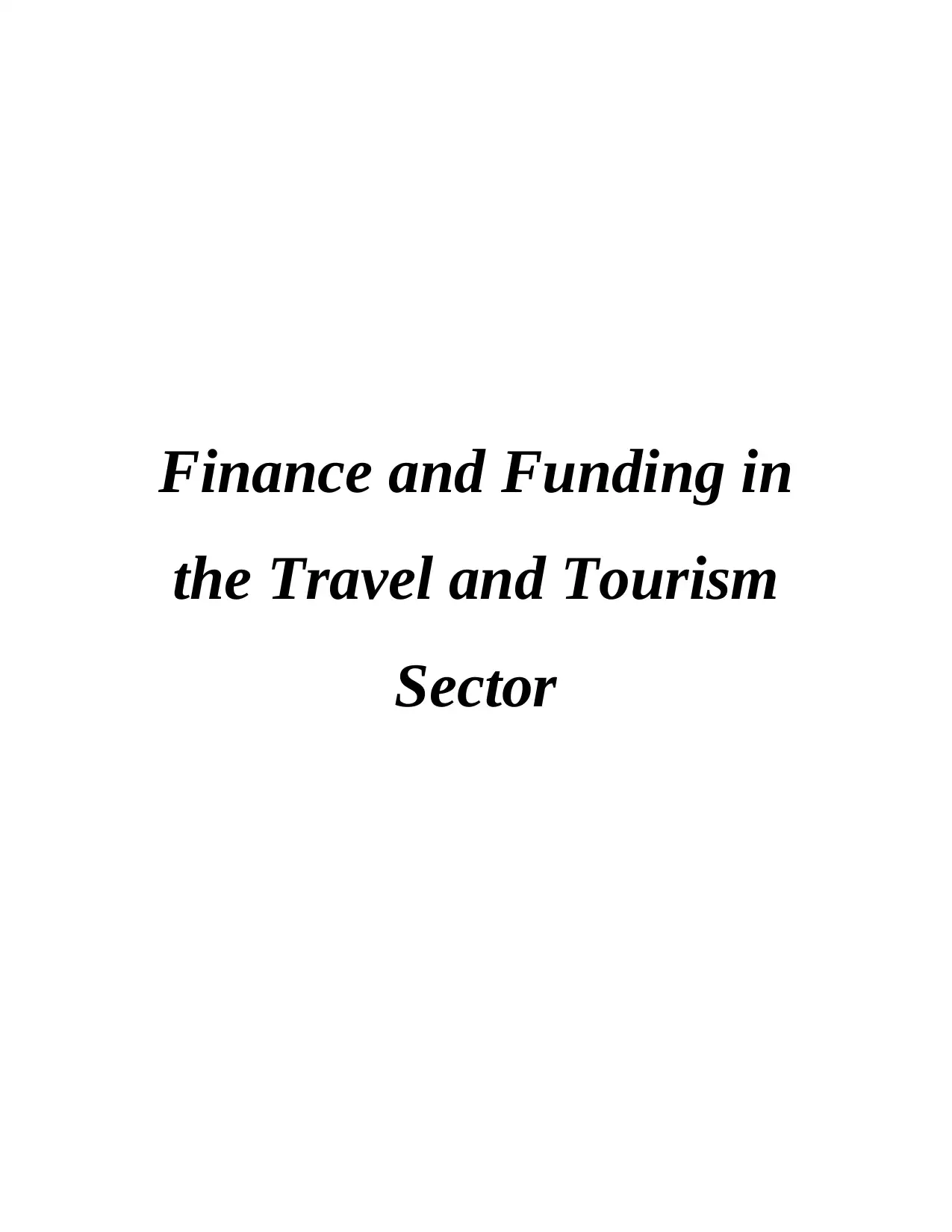
Finance and Funding in
the Travel and Tourism
Sector
the Travel and Tourism
Sector
Secure Best Marks with AI Grader
Need help grading? Try our AI Grader for instant feedback on your assignments.
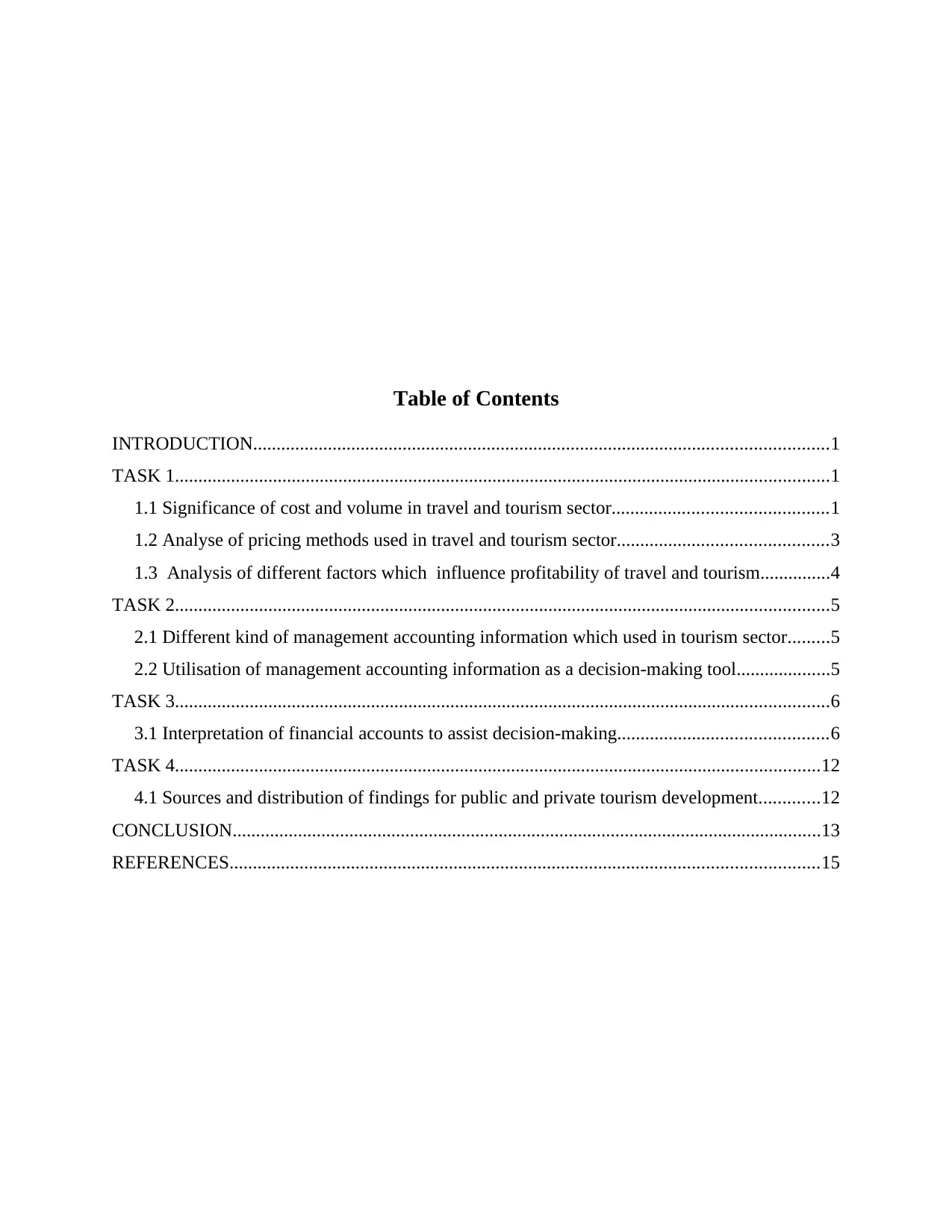
Table of Contents
INTRODUCTION...........................................................................................................................1
TASK 1............................................................................................................................................1
1.1 Significance of cost and volume in travel and tourism sector..............................................1
1.2 Analyse of pricing methods used in travel and tourism sector.............................................3
1.3 Analysis of different factors which influence profitability of travel and tourism...............4
TASK 2............................................................................................................................................5
2.1 Different kind of management accounting information which used in tourism sector.........5
2.2 Utilisation of management accounting information as a decision-making tool....................5
TASK 3............................................................................................................................................6
3.1 Interpretation of financial accounts to assist decision-making.............................................6
TASK 4..........................................................................................................................................12
4.1 Sources and distribution of findings for public and private tourism development.............12
CONCLUSION..............................................................................................................................13
REFERENCES..............................................................................................................................15
INTRODUCTION...........................................................................................................................1
TASK 1............................................................................................................................................1
1.1 Significance of cost and volume in travel and tourism sector..............................................1
1.2 Analyse of pricing methods used in travel and tourism sector.............................................3
1.3 Analysis of different factors which influence profitability of travel and tourism...............4
TASK 2............................................................................................................................................5
2.1 Different kind of management accounting information which used in tourism sector.........5
2.2 Utilisation of management accounting information as a decision-making tool....................5
TASK 3............................................................................................................................................6
3.1 Interpretation of financial accounts to assist decision-making.............................................6
TASK 4..........................................................................................................................................12
4.1 Sources and distribution of findings for public and private tourism development.............12
CONCLUSION..............................................................................................................................13
REFERENCES..............................................................................................................................15
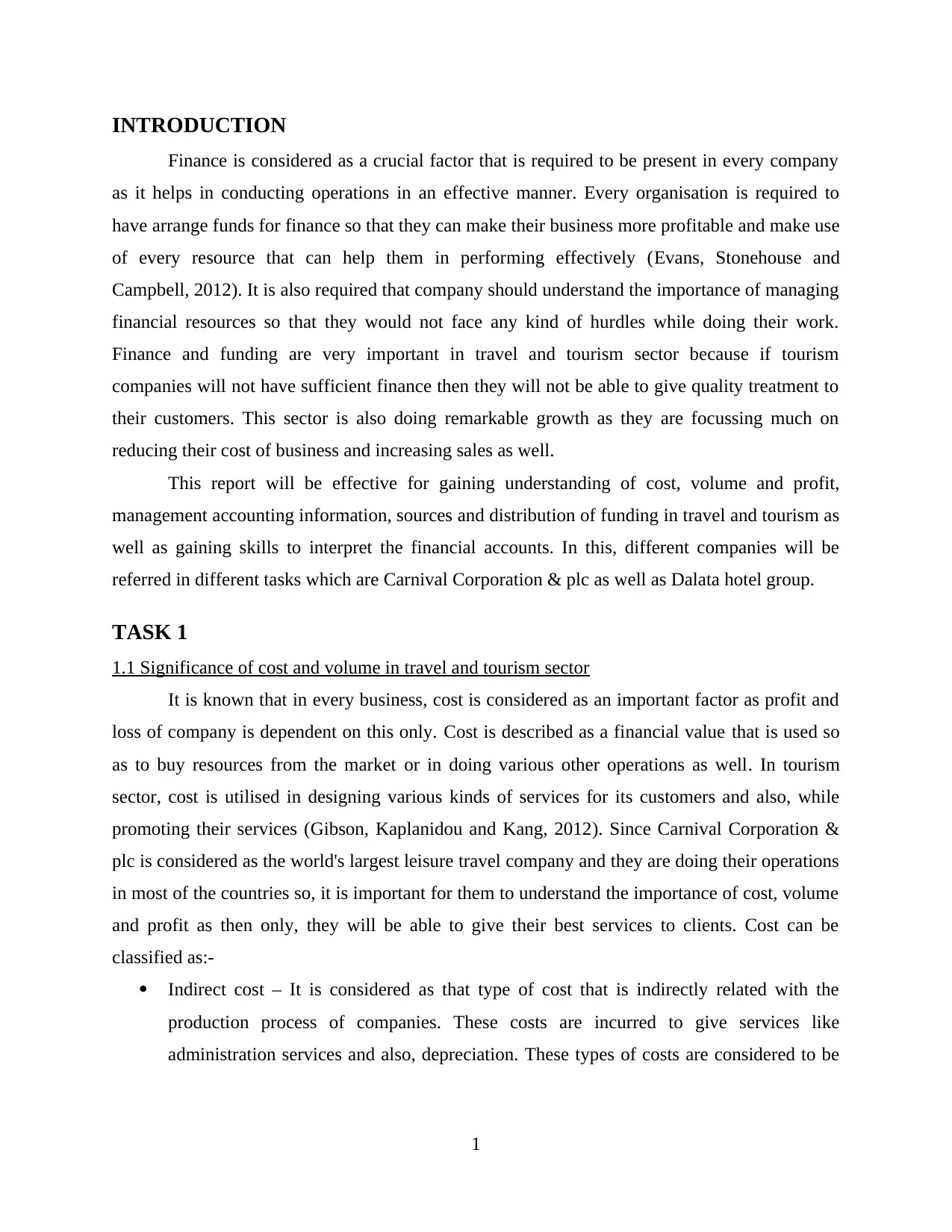
INTRODUCTION
Finance is considered as a crucial factor that is required to be present in every company
as it helps in conducting operations in an effective manner. Every organisation is required to
have arrange funds for finance so that they can make their business more profitable and make use
of every resource that can help them in performing effectively (Evans, Stonehouse and
Campbell, 2012). It is also required that company should understand the importance of managing
financial resources so that they would not face any kind of hurdles while doing their work.
Finance and funding are very important in travel and tourism sector because if tourism
companies will not have sufficient finance then they will not be able to give quality treatment to
their customers. This sector is also doing remarkable growth as they are focussing much on
reducing their cost of business and increasing sales as well.
This report will be effective for gaining understanding of cost, volume and profit,
management accounting information, sources and distribution of funding in travel and tourism as
well as gaining skills to interpret the financial accounts. In this, different companies will be
referred in different tasks which are Carnival Corporation & plc as well as Dalata hotel group.
TASK 1
1.1 Significance of cost and volume in travel and tourism sector
It is known that in every business, cost is considered as an important factor as profit and
loss of company is dependent on this only. Cost is described as a financial value that is used so
as to buy resources from the market or in doing various other operations as well. In tourism
sector, cost is utilised in designing various kinds of services for its customers and also, while
promoting their services (Gibson, Kaplanidou and Kang, 2012). Since Carnival Corporation &
plc is considered as the world's largest leisure travel company and they are doing their operations
in most of the countries so, it is important for them to understand the importance of cost, volume
and profit as then only, they will be able to give their best services to clients. Cost can be
classified as:-
Indirect cost – It is considered as that type of cost that is indirectly related with the
production process of companies. These costs are incurred to give services like
administration services and also, depreciation. These types of costs are considered to be
1
Finance is considered as a crucial factor that is required to be present in every company
as it helps in conducting operations in an effective manner. Every organisation is required to
have arrange funds for finance so that they can make their business more profitable and make use
of every resource that can help them in performing effectively (Evans, Stonehouse and
Campbell, 2012). It is also required that company should understand the importance of managing
financial resources so that they would not face any kind of hurdles while doing their work.
Finance and funding are very important in travel and tourism sector because if tourism
companies will not have sufficient finance then they will not be able to give quality treatment to
their customers. This sector is also doing remarkable growth as they are focussing much on
reducing their cost of business and increasing sales as well.
This report will be effective for gaining understanding of cost, volume and profit,
management accounting information, sources and distribution of funding in travel and tourism as
well as gaining skills to interpret the financial accounts. In this, different companies will be
referred in different tasks which are Carnival Corporation & plc as well as Dalata hotel group.
TASK 1
1.1 Significance of cost and volume in travel and tourism sector
It is known that in every business, cost is considered as an important factor as profit and
loss of company is dependent on this only. Cost is described as a financial value that is used so
as to buy resources from the market or in doing various other operations as well. In tourism
sector, cost is utilised in designing various kinds of services for its customers and also, while
promoting their services (Gibson, Kaplanidou and Kang, 2012). Since Carnival Corporation &
plc is considered as the world's largest leisure travel company and they are doing their operations
in most of the countries so, it is important for them to understand the importance of cost, volume
and profit as then only, they will be able to give their best services to clients. Cost can be
classified as:-
Indirect cost – It is considered as that type of cost that is indirectly related with the
production process of companies. These costs are incurred to give services like
administration services and also, depreciation. These types of costs are considered to be
1
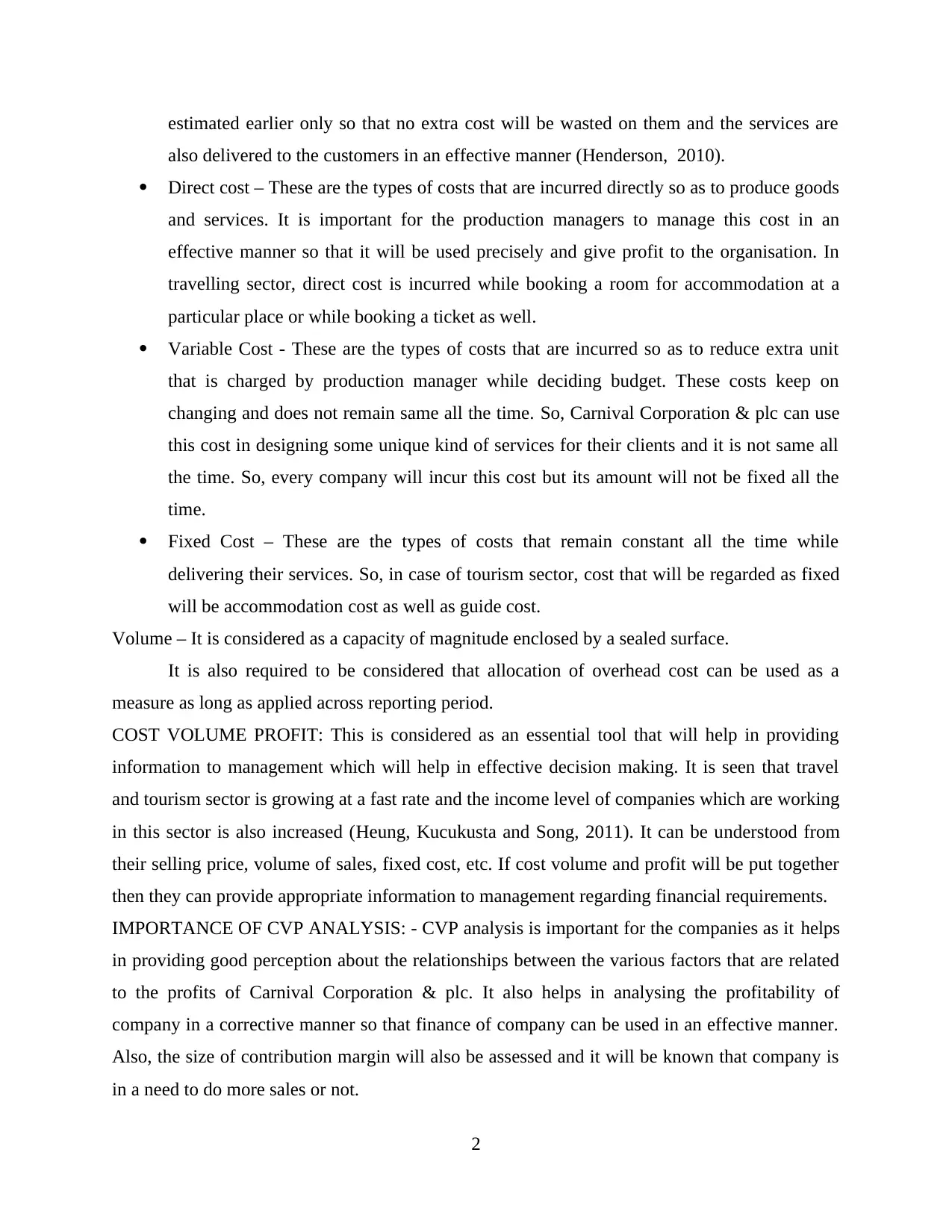
estimated earlier only so that no extra cost will be wasted on them and the services are
also delivered to the customers in an effective manner (Henderson, 2010).
Direct cost – These are the types of costs that are incurred directly so as to produce goods
and services. It is important for the production managers to manage this cost in an
effective manner so that it will be used precisely and give profit to the organisation. In
travelling sector, direct cost is incurred while booking a room for accommodation at a
particular place or while booking a ticket as well.
Variable Cost - These are the types of costs that are incurred so as to reduce extra unit
that is charged by production manager while deciding budget. These costs keep on
changing and does not remain same all the time. So, Carnival Corporation & plc can use
this cost in designing some unique kind of services for their clients and it is not same all
the time. So, every company will incur this cost but its amount will not be fixed all the
time.
Fixed Cost – These are the types of costs that remain constant all the time while
delivering their services. So, in case of tourism sector, cost that will be regarded as fixed
will be accommodation cost as well as guide cost.
Volume – It is considered as a capacity of magnitude enclosed by a sealed surface.
It is also required to be considered that allocation of overhead cost can be used as a
measure as long as applied across reporting period.
COST VOLUME PROFIT: This is considered as an essential tool that will help in providing
information to management which will help in effective decision making. It is seen that travel
and tourism sector is growing at a fast rate and the income level of companies which are working
in this sector is also increased (Heung, Kucukusta and Song, 2011). It can be understood from
their selling price, volume of sales, fixed cost, etc. If cost volume and profit will be put together
then they can provide appropriate information to management regarding financial requirements.
IMPORTANCE OF CVP ANALYSIS: - CVP analysis is important for the companies as it helps
in providing good perception about the relationships between the various factors that are related
to the profits of Carnival Corporation & plc. It also helps in analysing the profitability of
company in a corrective manner so that finance of company can be used in an effective manner.
Also, the size of contribution margin will also be assessed and it will be known that company is
in a need to do more sales or not.
2
also delivered to the customers in an effective manner (Henderson, 2010).
Direct cost – These are the types of costs that are incurred directly so as to produce goods
and services. It is important for the production managers to manage this cost in an
effective manner so that it will be used precisely and give profit to the organisation. In
travelling sector, direct cost is incurred while booking a room for accommodation at a
particular place or while booking a ticket as well.
Variable Cost - These are the types of costs that are incurred so as to reduce extra unit
that is charged by production manager while deciding budget. These costs keep on
changing and does not remain same all the time. So, Carnival Corporation & plc can use
this cost in designing some unique kind of services for their clients and it is not same all
the time. So, every company will incur this cost but its amount will not be fixed all the
time.
Fixed Cost – These are the types of costs that remain constant all the time while
delivering their services. So, in case of tourism sector, cost that will be regarded as fixed
will be accommodation cost as well as guide cost.
Volume – It is considered as a capacity of magnitude enclosed by a sealed surface.
It is also required to be considered that allocation of overhead cost can be used as a
measure as long as applied across reporting period.
COST VOLUME PROFIT: This is considered as an essential tool that will help in providing
information to management which will help in effective decision making. It is seen that travel
and tourism sector is growing at a fast rate and the income level of companies which are working
in this sector is also increased (Heung, Kucukusta and Song, 2011). It can be understood from
their selling price, volume of sales, fixed cost, etc. If cost volume and profit will be put together
then they can provide appropriate information to management regarding financial requirements.
IMPORTANCE OF CVP ANALYSIS: - CVP analysis is important for the companies as it helps
in providing good perception about the relationships between the various factors that are related
to the profits of Carnival Corporation & plc. It also helps in analysing the profitability of
company in a corrective manner so that finance of company can be used in an effective manner.
Also, the size of contribution margin will also be assessed and it will be known that company is
in a need to do more sales or not.
2
Secure Best Marks with AI Grader
Need help grading? Try our AI Grader for instant feedback on your assignments.
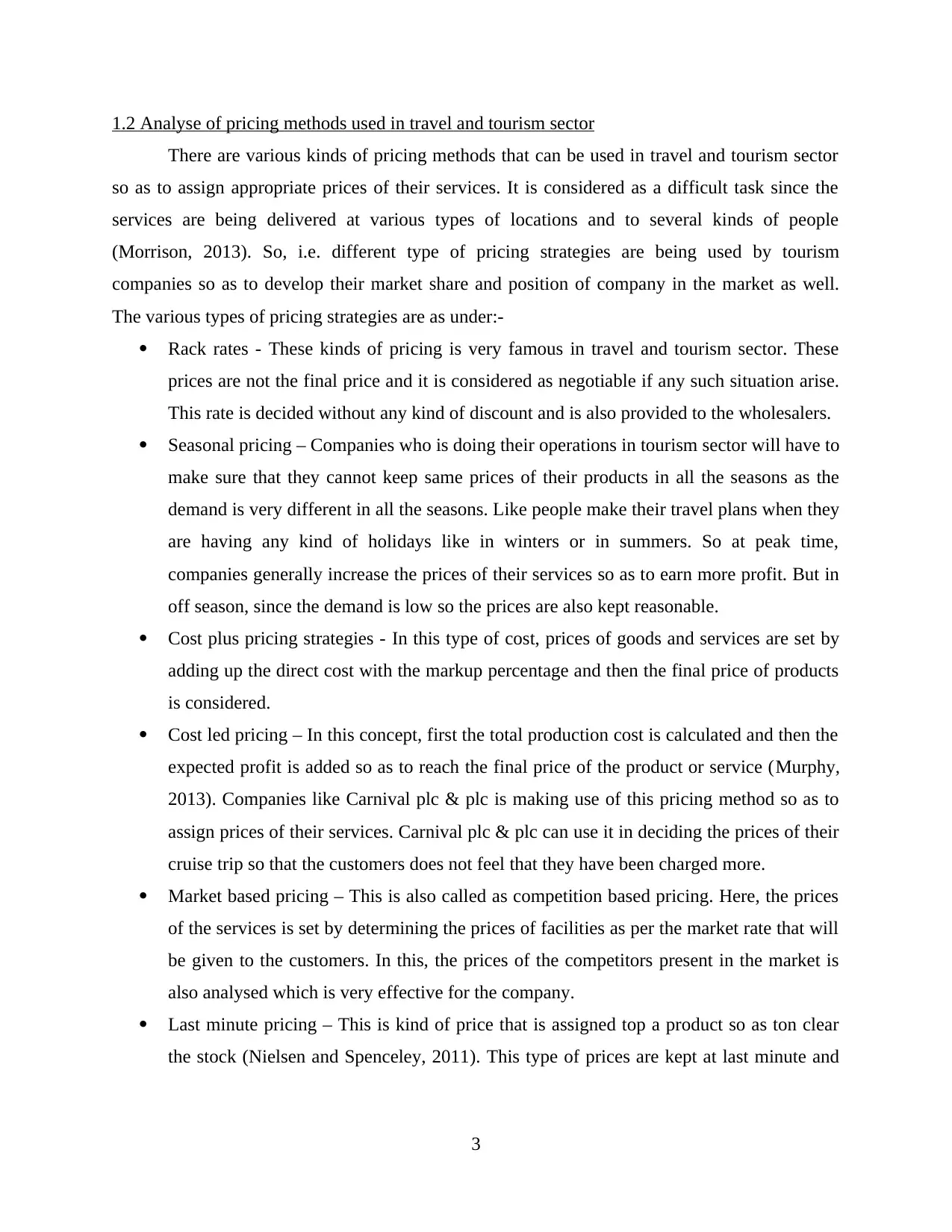
1.2 Analyse of pricing methods used in travel and tourism sector
There are various kinds of pricing methods that can be used in travel and tourism sector
so as to assign appropriate prices of their services. It is considered as a difficult task since the
services are being delivered at various types of locations and to several kinds of people
(Morrison, 2013). So, i.e. different type of pricing strategies are being used by tourism
companies so as to develop their market share and position of company in the market as well.
The various types of pricing strategies are as under:-
Rack rates - These kinds of pricing is very famous in travel and tourism sector. These
prices are not the final price and it is considered as negotiable if any such situation arise.
This rate is decided without any kind of discount and is also provided to the wholesalers.
Seasonal pricing – Companies who is doing their operations in tourism sector will have to
make sure that they cannot keep same prices of their products in all the seasons as the
demand is very different in all the seasons. Like people make their travel plans when they
are having any kind of holidays like in winters or in summers. So at peak time,
companies generally increase the prices of their services so as to earn more profit. But in
off season, since the demand is low so the prices are also kept reasonable.
Cost plus pricing strategies - In this type of cost, prices of goods and services are set by
adding up the direct cost with the markup percentage and then the final price of products
is considered.
Cost led pricing – In this concept, first the total production cost is calculated and then the
expected profit is added so as to reach the final price of the product or service (Murphy,
2013). Companies like Carnival plc & plc is making use of this pricing method so as to
assign prices of their services. Carnival plc & plc can use it in deciding the prices of their
cruise trip so that the customers does not feel that they have been charged more.
Market based pricing – This is also called as competition based pricing. Here, the prices
of the services is set by determining the prices of facilities as per the market rate that will
be given to the customers. In this, the prices of the competitors present in the market is
also analysed which is very effective for the company.
Last minute pricing – This is kind of price that is assigned top a product so as ton clear
the stock (Nielsen and Spenceley, 2011). This type of prices are kept at last minute and
3
There are various kinds of pricing methods that can be used in travel and tourism sector
so as to assign appropriate prices of their services. It is considered as a difficult task since the
services are being delivered at various types of locations and to several kinds of people
(Morrison, 2013). So, i.e. different type of pricing strategies are being used by tourism
companies so as to develop their market share and position of company in the market as well.
The various types of pricing strategies are as under:-
Rack rates - These kinds of pricing is very famous in travel and tourism sector. These
prices are not the final price and it is considered as negotiable if any such situation arise.
This rate is decided without any kind of discount and is also provided to the wholesalers.
Seasonal pricing – Companies who is doing their operations in tourism sector will have to
make sure that they cannot keep same prices of their products in all the seasons as the
demand is very different in all the seasons. Like people make their travel plans when they
are having any kind of holidays like in winters or in summers. So at peak time,
companies generally increase the prices of their services so as to earn more profit. But in
off season, since the demand is low so the prices are also kept reasonable.
Cost plus pricing strategies - In this type of cost, prices of goods and services are set by
adding up the direct cost with the markup percentage and then the final price of products
is considered.
Cost led pricing – In this concept, first the total production cost is calculated and then the
expected profit is added so as to reach the final price of the product or service (Murphy,
2013). Companies like Carnival plc & plc is making use of this pricing method so as to
assign prices of their services. Carnival plc & plc can use it in deciding the prices of their
cruise trip so that the customers does not feel that they have been charged more.
Market based pricing – This is also called as competition based pricing. Here, the prices
of the services is set by determining the prices of facilities as per the market rate that will
be given to the customers. In this, the prices of the competitors present in the market is
also analysed which is very effective for the company.
Last minute pricing – This is kind of price that is assigned top a product so as ton clear
the stock (Nielsen and Spenceley, 2011). This type of prices are kept at last minute and
3
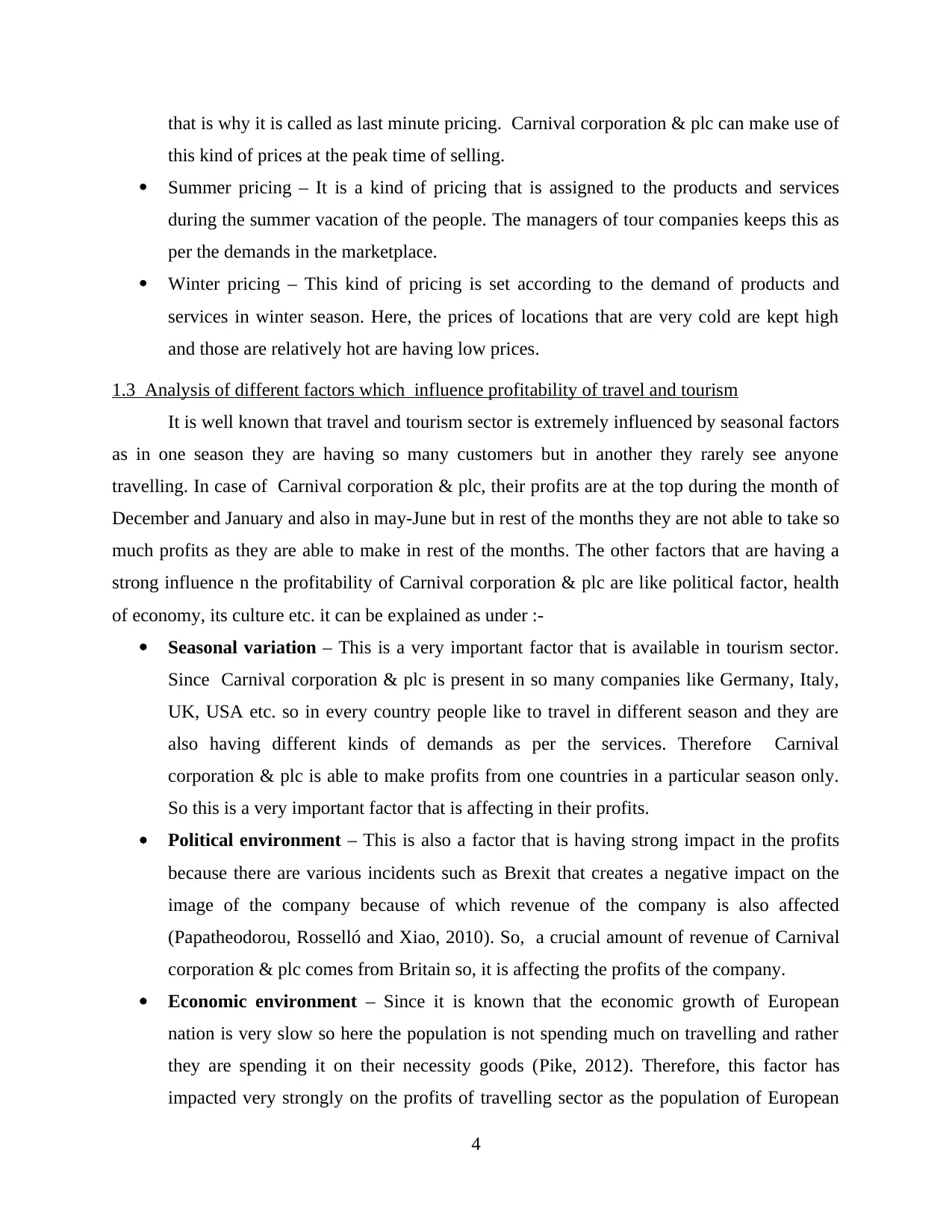
that is why it is called as last minute pricing. Carnival corporation & plc can make use of
this kind of prices at the peak time of selling.
Summer pricing – It is a kind of pricing that is assigned to the products and services
during the summer vacation of the people. The managers of tour companies keeps this as
per the demands in the marketplace.
Winter pricing – This kind of pricing is set according to the demand of products and
services in winter season. Here, the prices of locations that are very cold are kept high
and those are relatively hot are having low prices.
1.3 Analysis of different factors which influence profitability of travel and tourism
It is well known that travel and tourism sector is extremely influenced by seasonal factors
as in one season they are having so many customers but in another they rarely see anyone
travelling. In case of Carnival corporation & plc, their profits are at the top during the month of
December and January and also in may-June but in rest of the months they are not able to take so
much profits as they are able to make in rest of the months. The other factors that are having a
strong influence n the profitability of Carnival corporation & plc are like political factor, health
of economy, its culture etc. it can be explained as under :-
Seasonal variation – This is a very important factor that is available in tourism sector.
Since Carnival corporation & plc is present in so many companies like Germany, Italy,
UK, USA etc. so in every country people like to travel in different season and they are
also having different kinds of demands as per the services. Therefore Carnival
corporation & plc is able to make profits from one countries in a particular season only.
So this is a very important factor that is affecting in their profits.
Political environment – This is also a factor that is having strong impact in the profits
because there are various incidents such as Brexit that creates a negative impact on the
image of the company because of which revenue of the company is also affected
(Papatheodorou, Rosselló and Xiao, 2010). So, a crucial amount of revenue of Carnival
corporation & plc comes from Britain so, it is affecting the profits of the company.
Economic environment – Since it is known that the economic growth of European
nation is very slow so here the population is not spending much on travelling and rather
they are spending it on their necessity goods (Pike, 2012). Therefore, this factor has
impacted very strongly on the profits of travelling sector as the population of European
4
this kind of prices at the peak time of selling.
Summer pricing – It is a kind of pricing that is assigned to the products and services
during the summer vacation of the people. The managers of tour companies keeps this as
per the demands in the marketplace.
Winter pricing – This kind of pricing is set according to the demand of products and
services in winter season. Here, the prices of locations that are very cold are kept high
and those are relatively hot are having low prices.
1.3 Analysis of different factors which influence profitability of travel and tourism
It is well known that travel and tourism sector is extremely influenced by seasonal factors
as in one season they are having so many customers but in another they rarely see anyone
travelling. In case of Carnival corporation & plc, their profits are at the top during the month of
December and January and also in may-June but in rest of the months they are not able to take so
much profits as they are able to make in rest of the months. The other factors that are having a
strong influence n the profitability of Carnival corporation & plc are like political factor, health
of economy, its culture etc. it can be explained as under :-
Seasonal variation – This is a very important factor that is available in tourism sector.
Since Carnival corporation & plc is present in so many companies like Germany, Italy,
UK, USA etc. so in every country people like to travel in different season and they are
also having different kinds of demands as per the services. Therefore Carnival
corporation & plc is able to make profits from one countries in a particular season only.
So this is a very important factor that is affecting in their profits.
Political environment – This is also a factor that is having strong impact in the profits
because there are various incidents such as Brexit that creates a negative impact on the
image of the company because of which revenue of the company is also affected
(Papatheodorou, Rosselló and Xiao, 2010). So, a crucial amount of revenue of Carnival
corporation & plc comes from Britain so, it is affecting the profits of the company.
Economic environment – Since it is known that the economic growth of European
nation is very slow so here the population is not spending much on travelling and rather
they are spending it on their necessity goods (Pike, 2012). Therefore, this factor has
impacted very strongly on the profits of travelling sector as the population of European
4
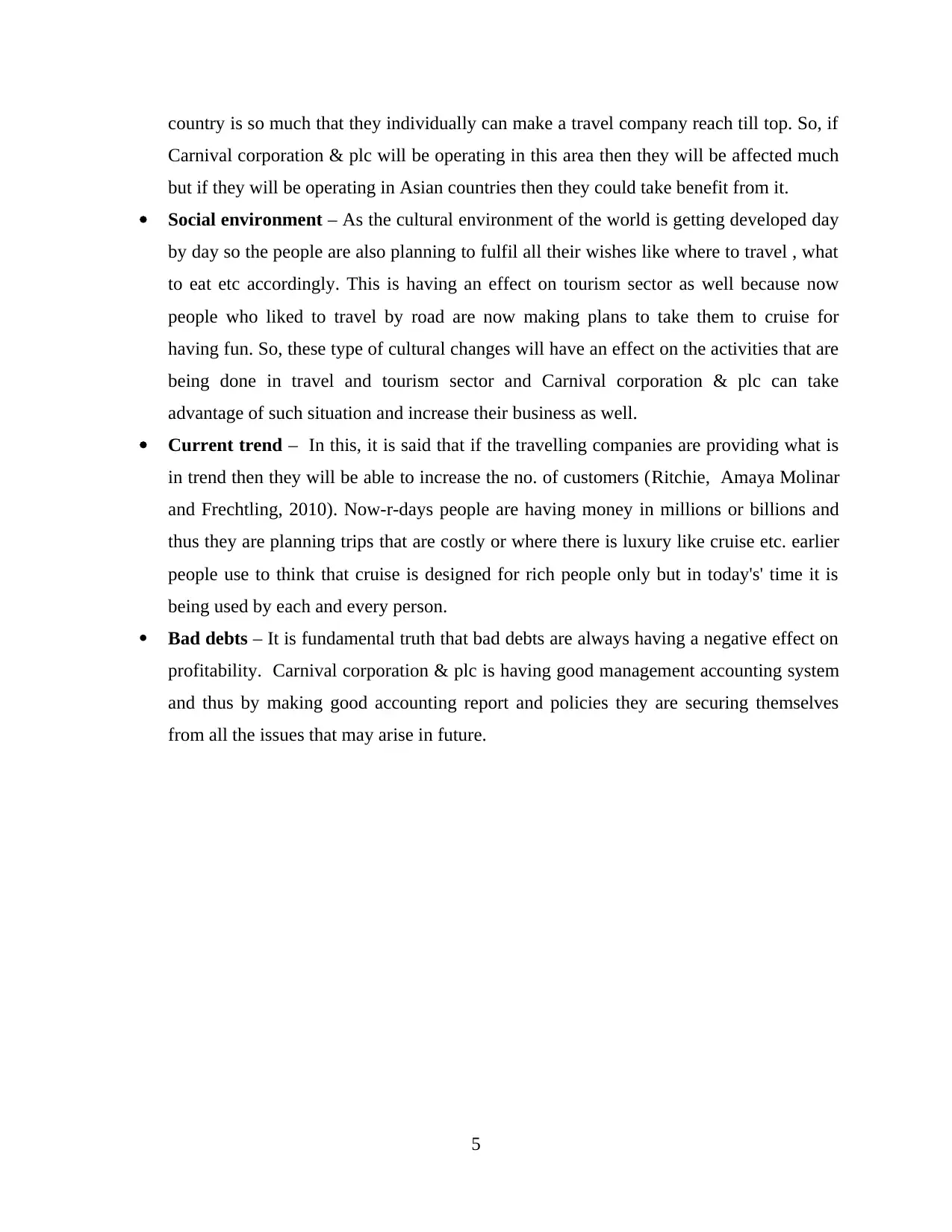
country is so much that they individually can make a travel company reach till top. So, if
Carnival corporation & plc will be operating in this area then they will be affected much
but if they will be operating in Asian countries then they could take benefit from it.
Social environment – As the cultural environment of the world is getting developed day
by day so the people are also planning to fulfil all their wishes like where to travel , what
to eat etc accordingly. This is having an effect on tourism sector as well because now
people who liked to travel by road are now making plans to take them to cruise for
having fun. So, these type of cultural changes will have an effect on the activities that are
being done in travel and tourism sector and Carnival corporation & plc can take
advantage of such situation and increase their business as well.
Current trend – In this, it is said that if the travelling companies are providing what is
in trend then they will be able to increase the no. of customers (Ritchie, Amaya Molinar
and Frechtling, 2010). Now-r-days people are having money in millions or billions and
thus they are planning trips that are costly or where there is luxury like cruise etc. earlier
people use to think that cruise is designed for rich people only but in today's' time it is
being used by each and every person.
Bad debts – It is fundamental truth that bad debts are always having a negative effect on
profitability. Carnival corporation & plc is having good management accounting system
and thus by making good accounting report and policies they are securing themselves
from all the issues that may arise in future.
5
Carnival corporation & plc will be operating in this area then they will be affected much
but if they will be operating in Asian countries then they could take benefit from it.
Social environment – As the cultural environment of the world is getting developed day
by day so the people are also planning to fulfil all their wishes like where to travel , what
to eat etc accordingly. This is having an effect on tourism sector as well because now
people who liked to travel by road are now making plans to take them to cruise for
having fun. So, these type of cultural changes will have an effect on the activities that are
being done in travel and tourism sector and Carnival corporation & plc can take
advantage of such situation and increase their business as well.
Current trend – In this, it is said that if the travelling companies are providing what is
in trend then they will be able to increase the no. of customers (Ritchie, Amaya Molinar
and Frechtling, 2010). Now-r-days people are having money in millions or billions and
thus they are planning trips that are costly or where there is luxury like cruise etc. earlier
people use to think that cruise is designed for rich people only but in today's' time it is
being used by each and every person.
Bad debts – It is fundamental truth that bad debts are always having a negative effect on
profitability. Carnival corporation & plc is having good management accounting system
and thus by making good accounting report and policies they are securing themselves
from all the issues that may arise in future.
5
Paraphrase This Document
Need a fresh take? Get an instant paraphrase of this document with our AI Paraphraser
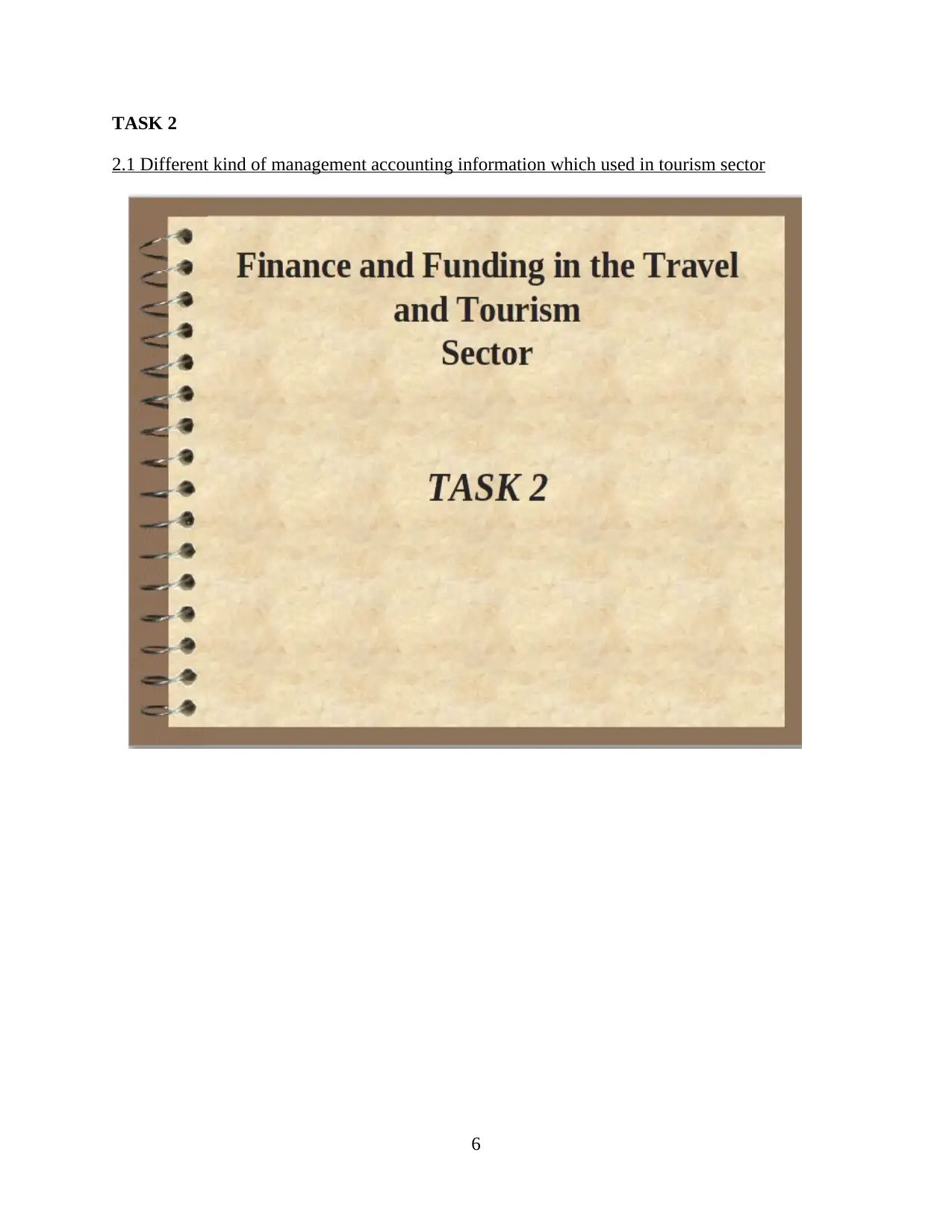
TASK 2
2.1 Different kind of management accounting information which used in tourism sector
6
2.1 Different kind of management accounting information which used in tourism sector
6
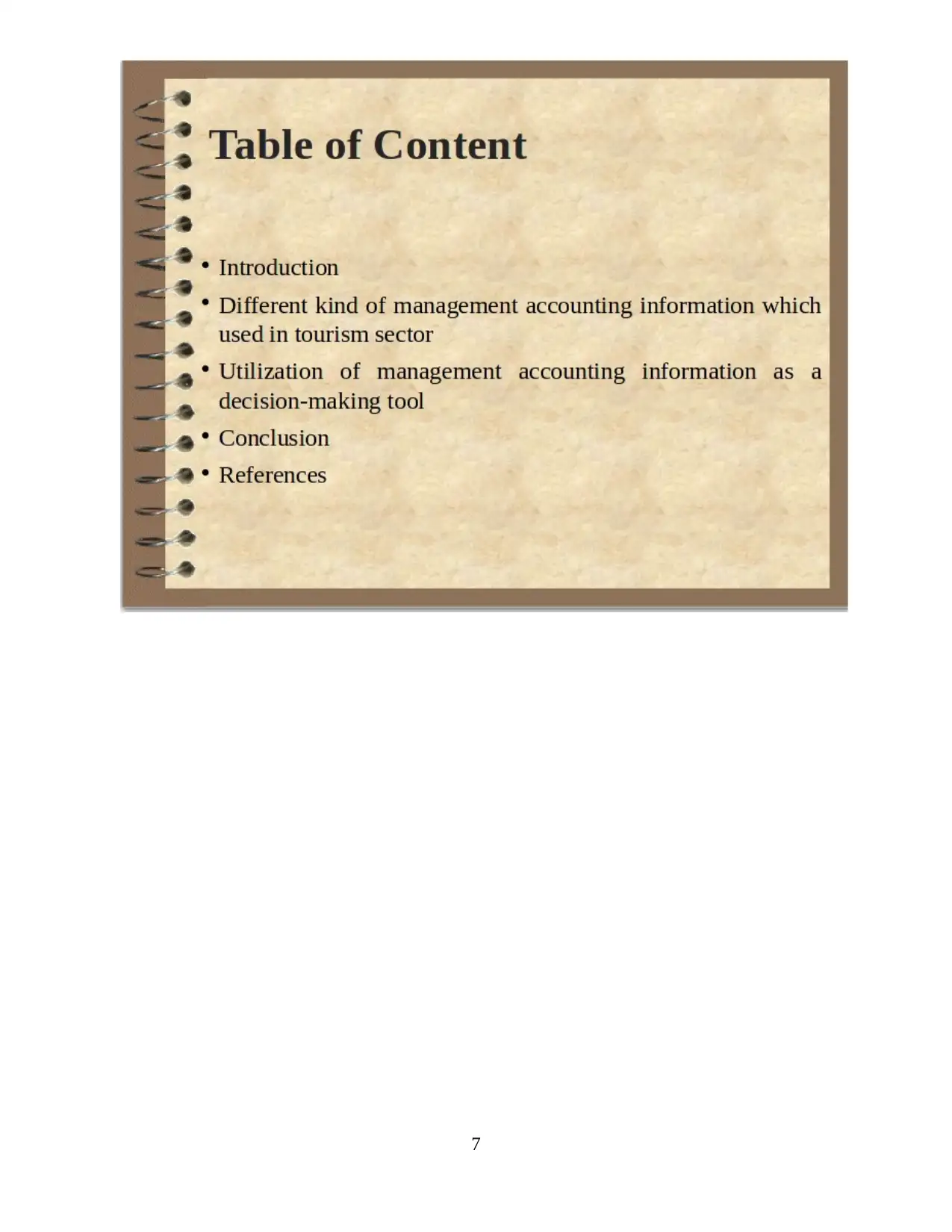
7
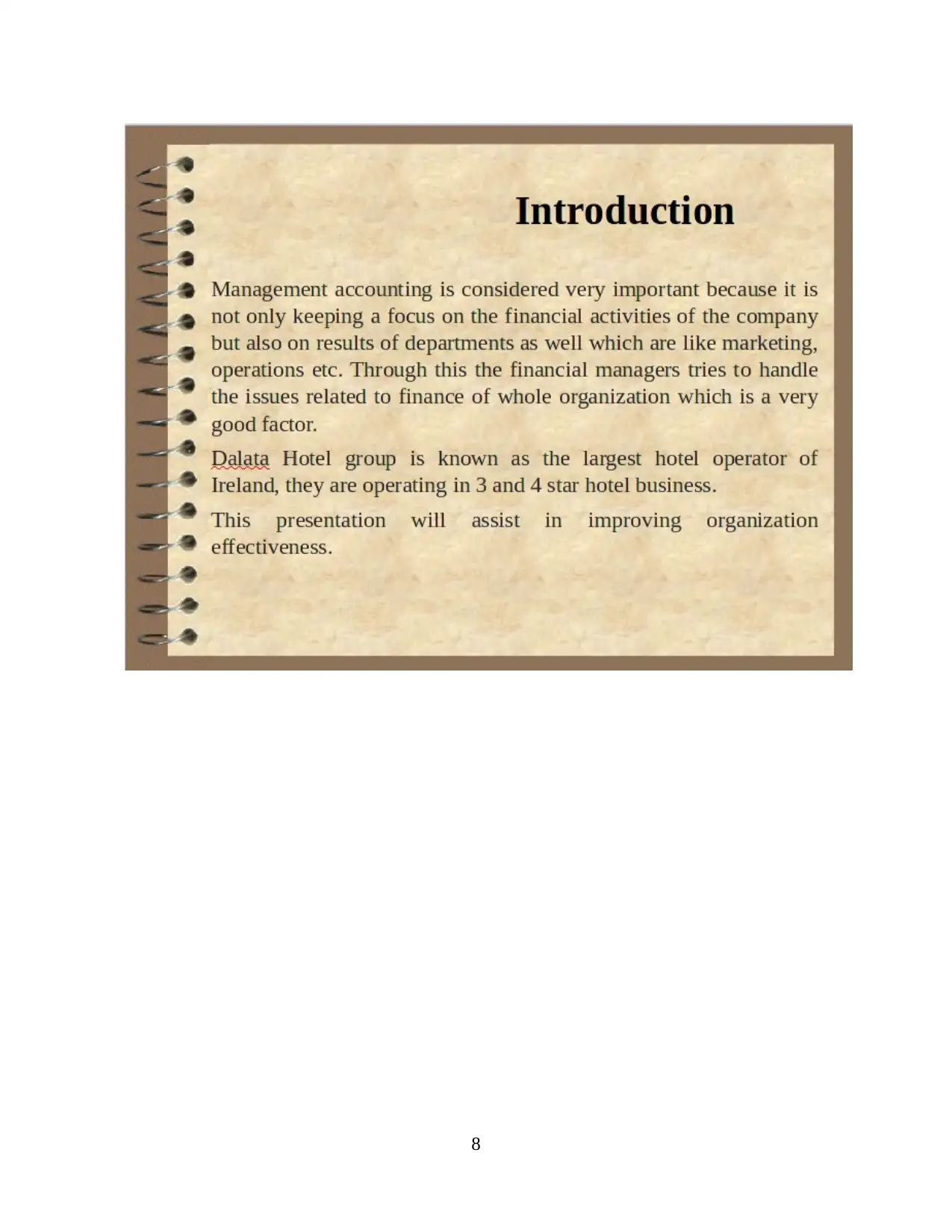
8
Secure Best Marks with AI Grader
Need help grading? Try our AI Grader for instant feedback on your assignments.
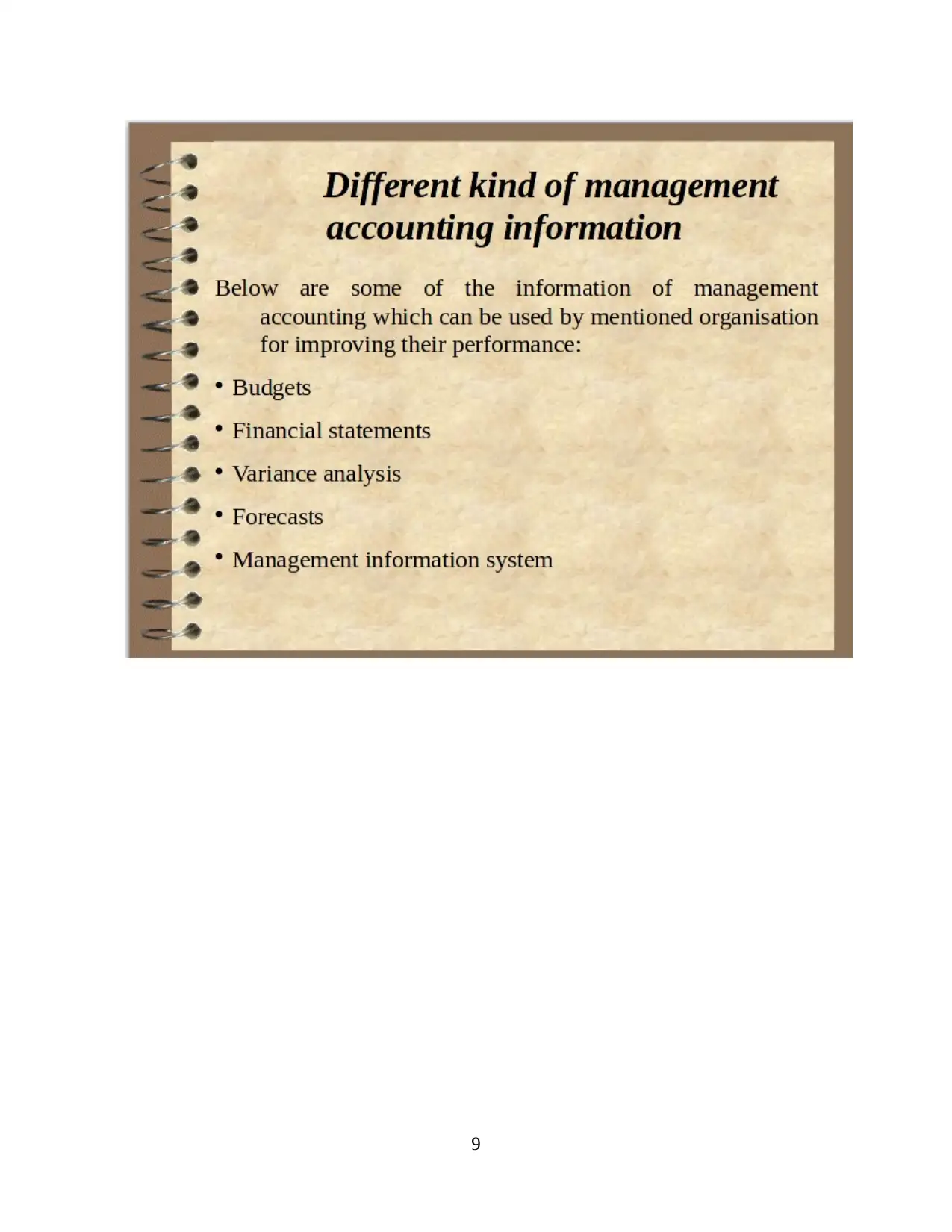
9
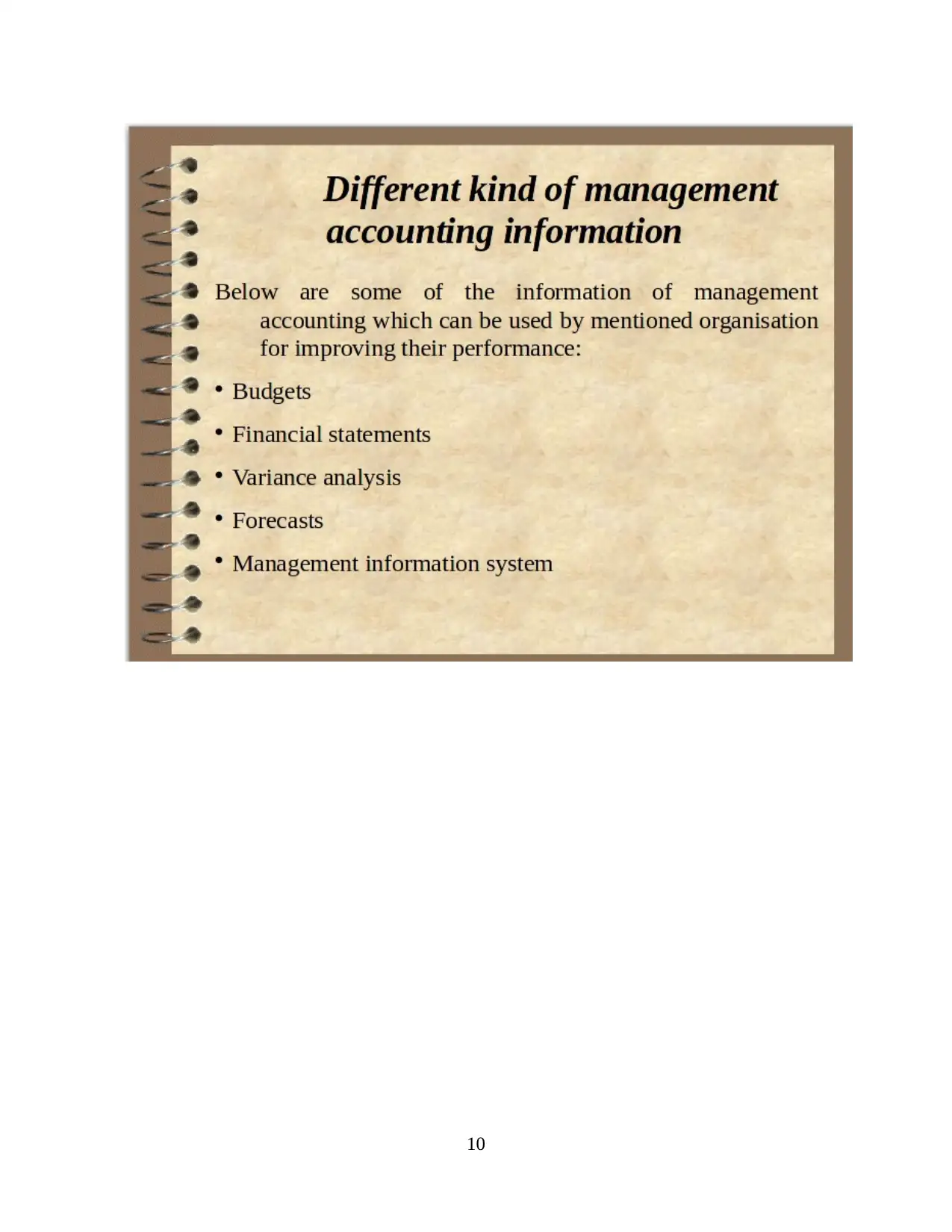
10
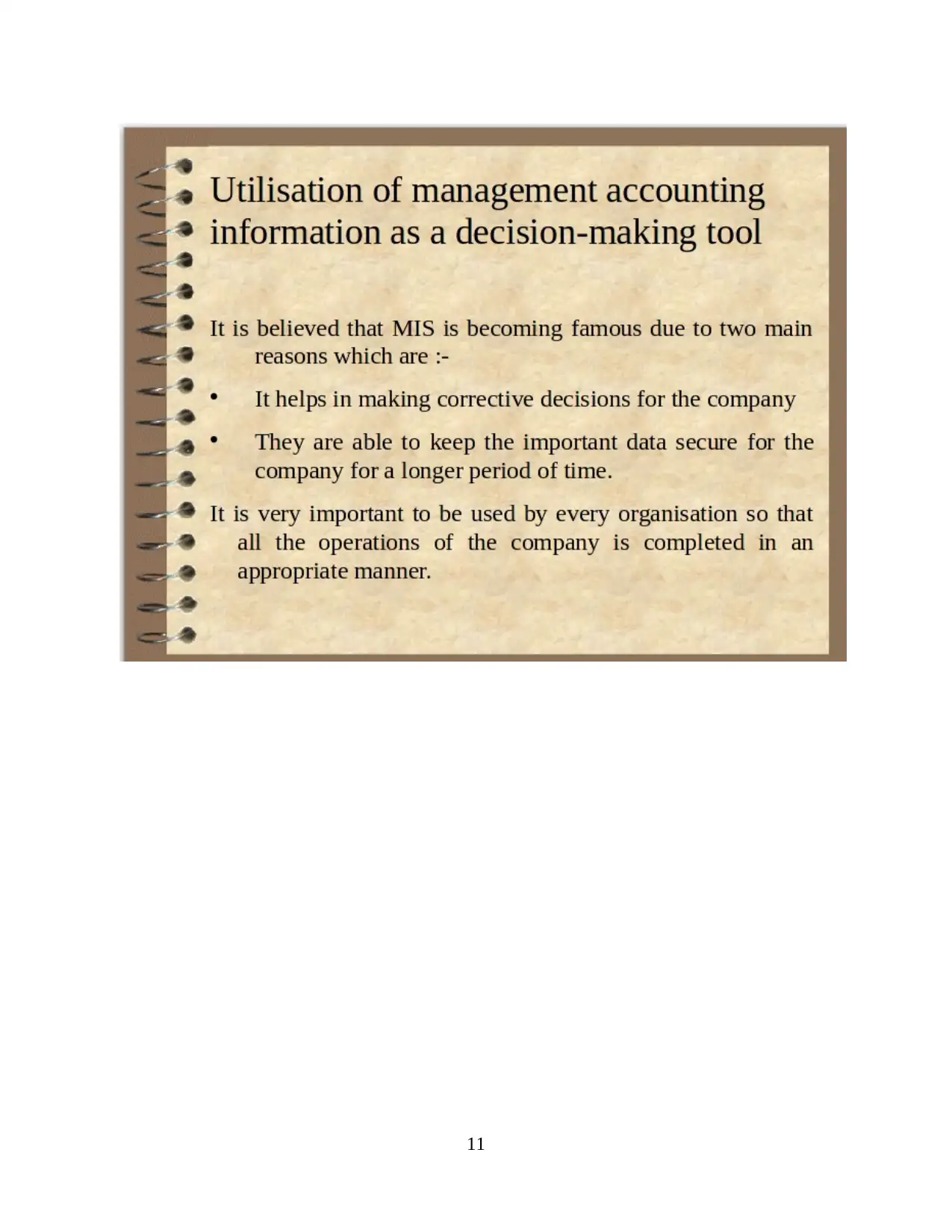
11
Paraphrase This Document
Need a fresh take? Get an instant paraphrase of this document with our AI Paraphraser
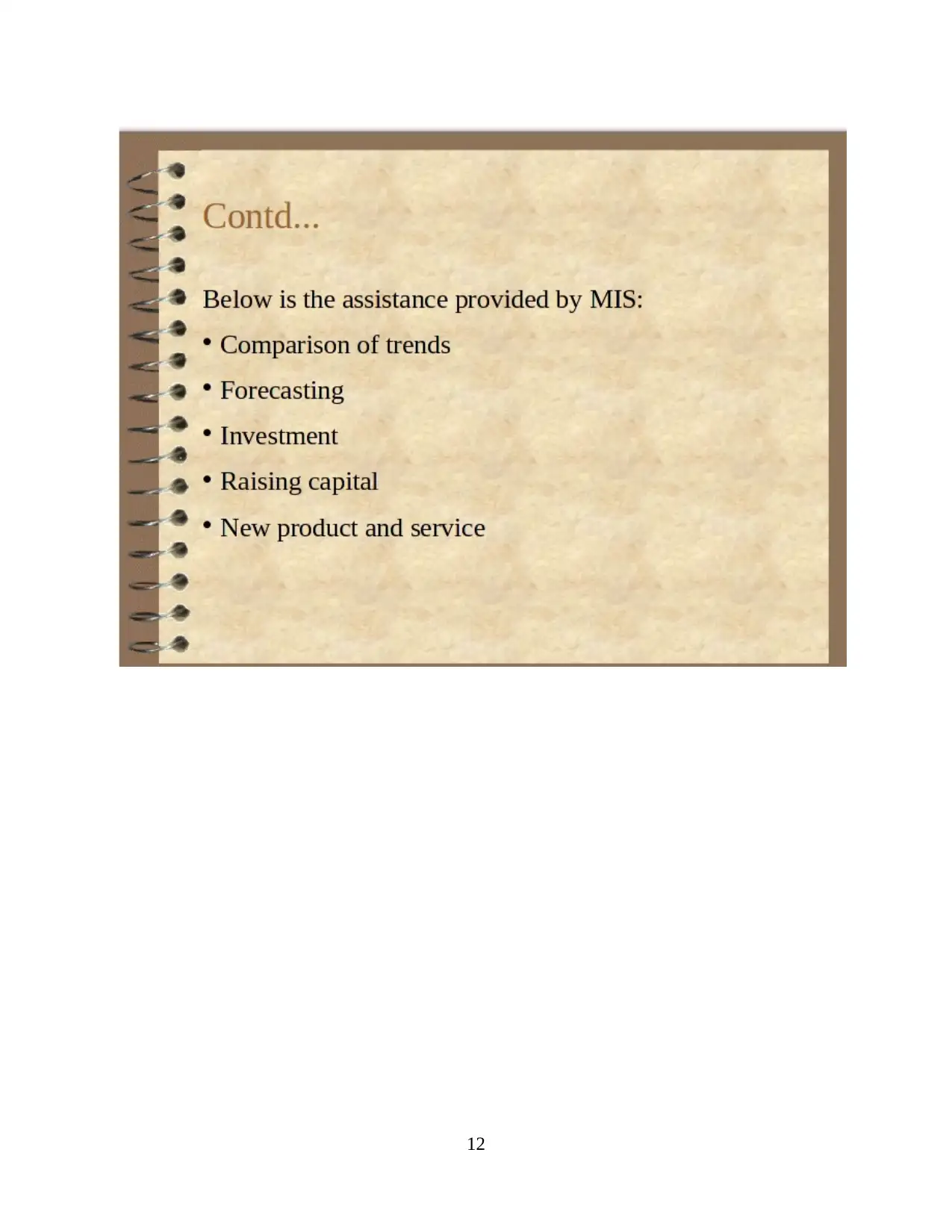
12
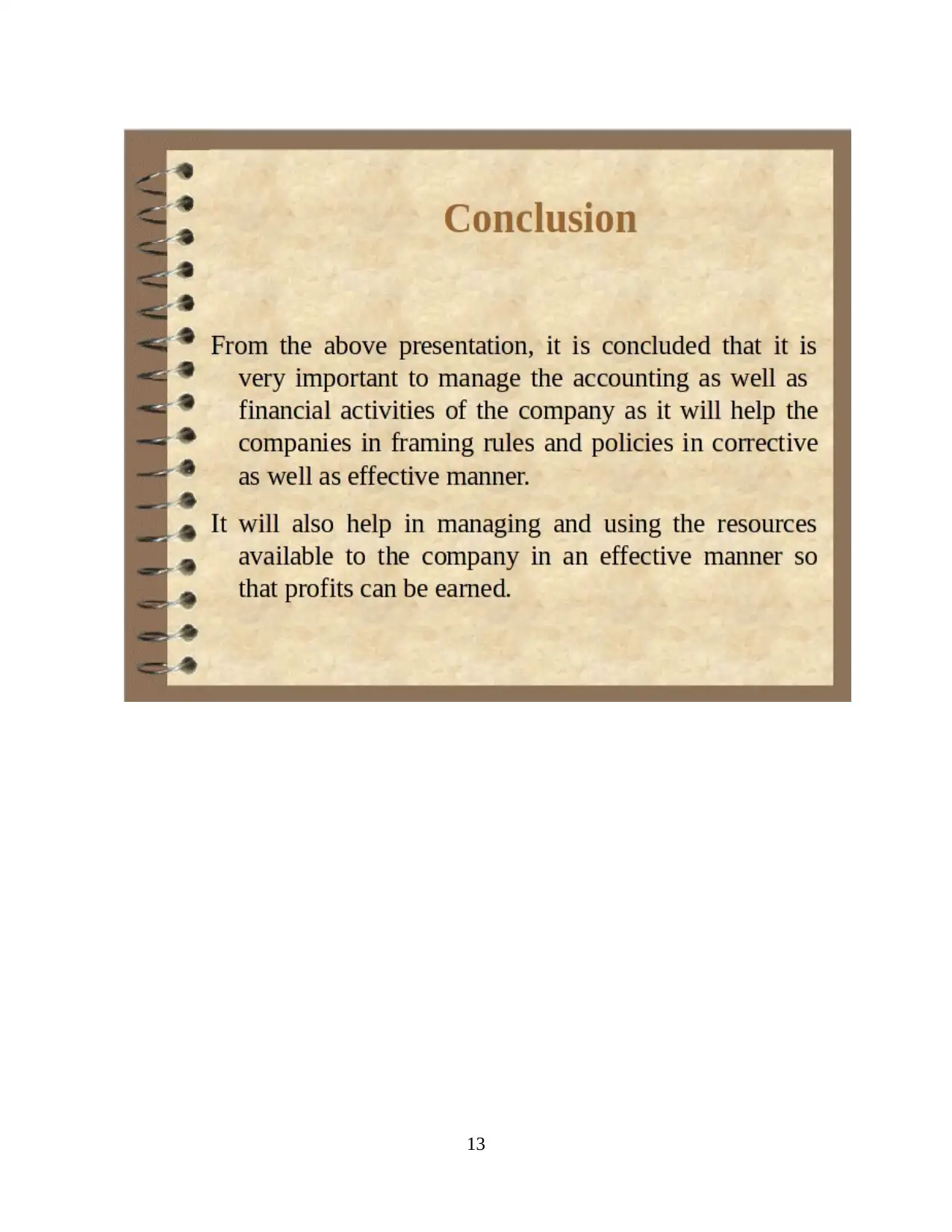
13
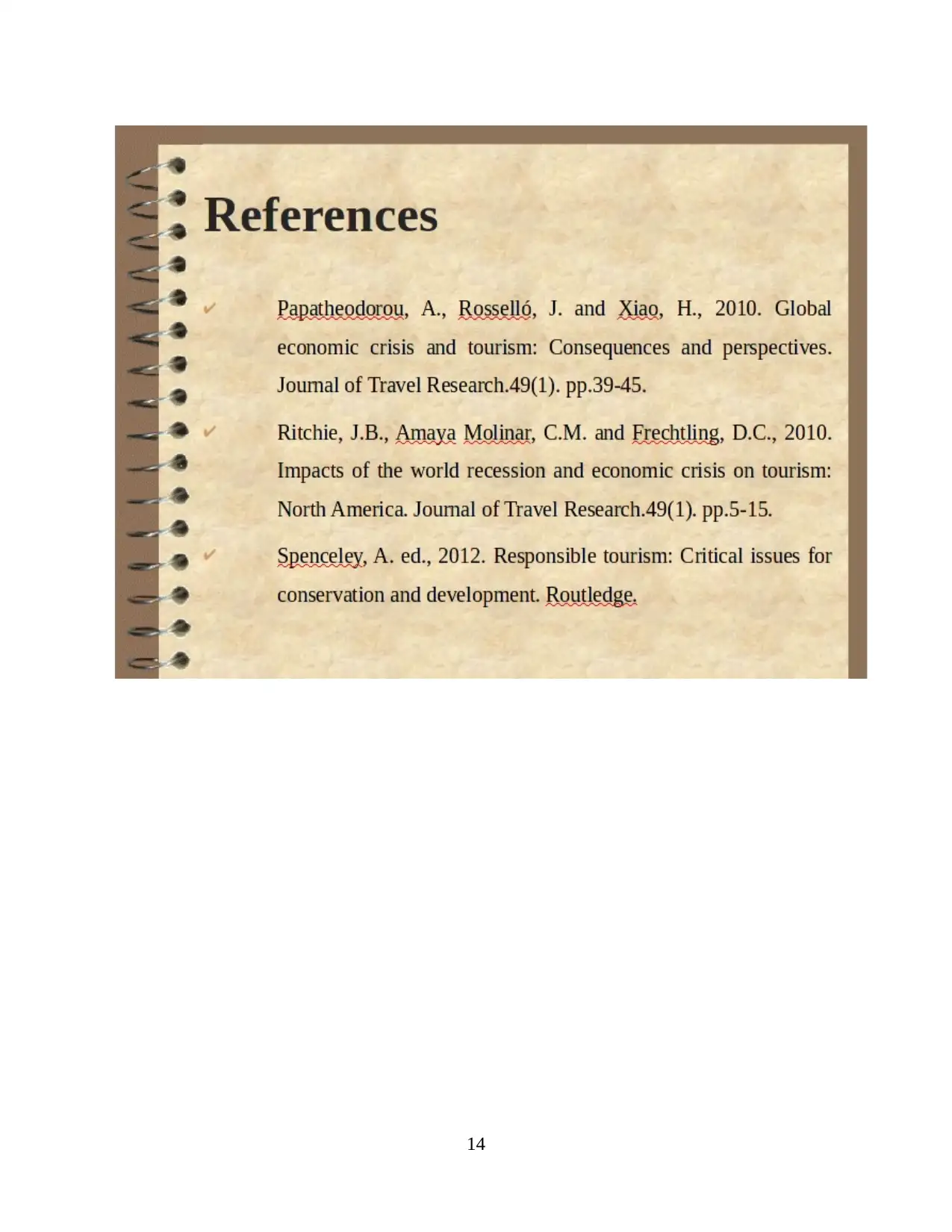
14
Secure Best Marks with AI Grader
Need help grading? Try our AI Grader for instant feedback on your assignments.
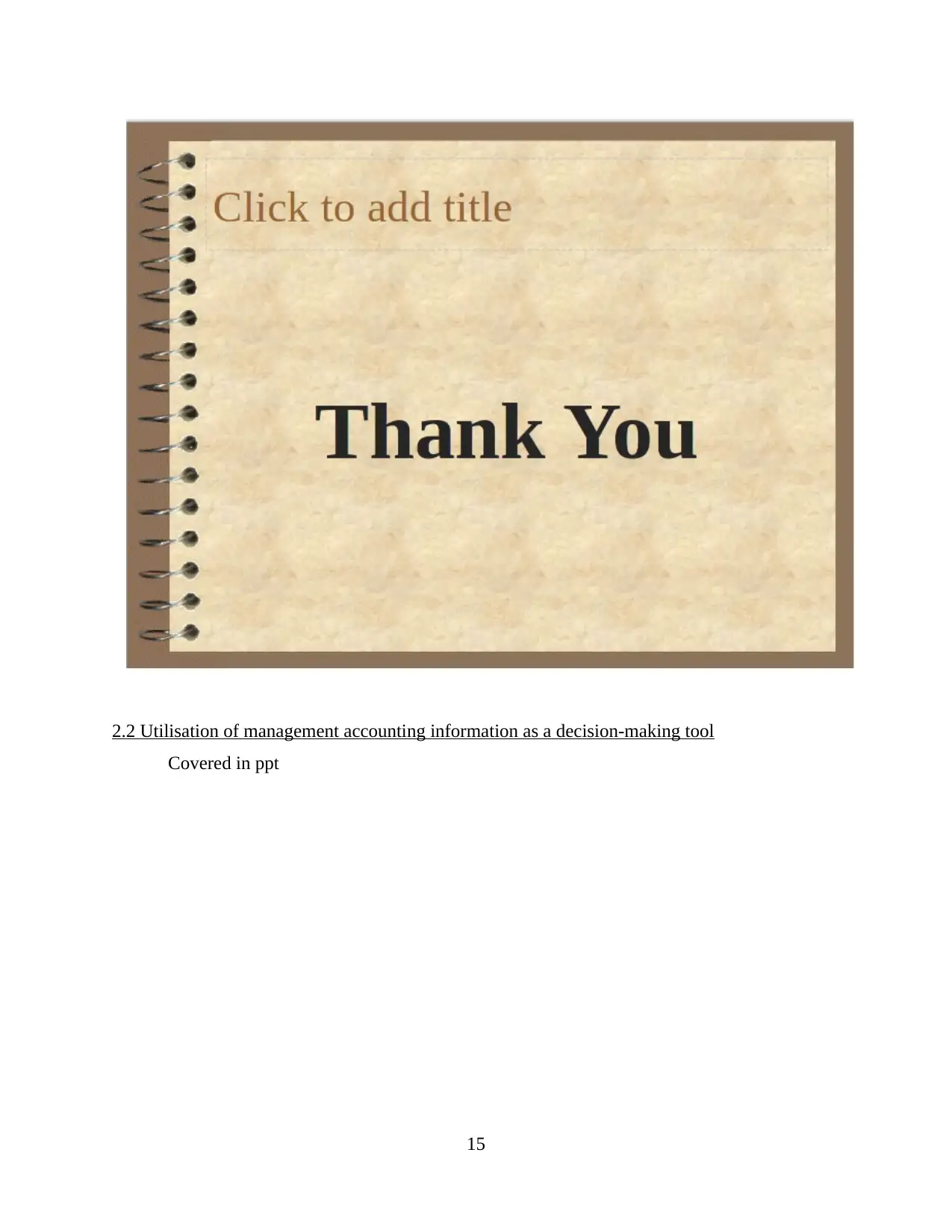
2.2 Utilisation of management accounting information as a decision-making tool
Covered in ppt
15
Covered in ppt
15
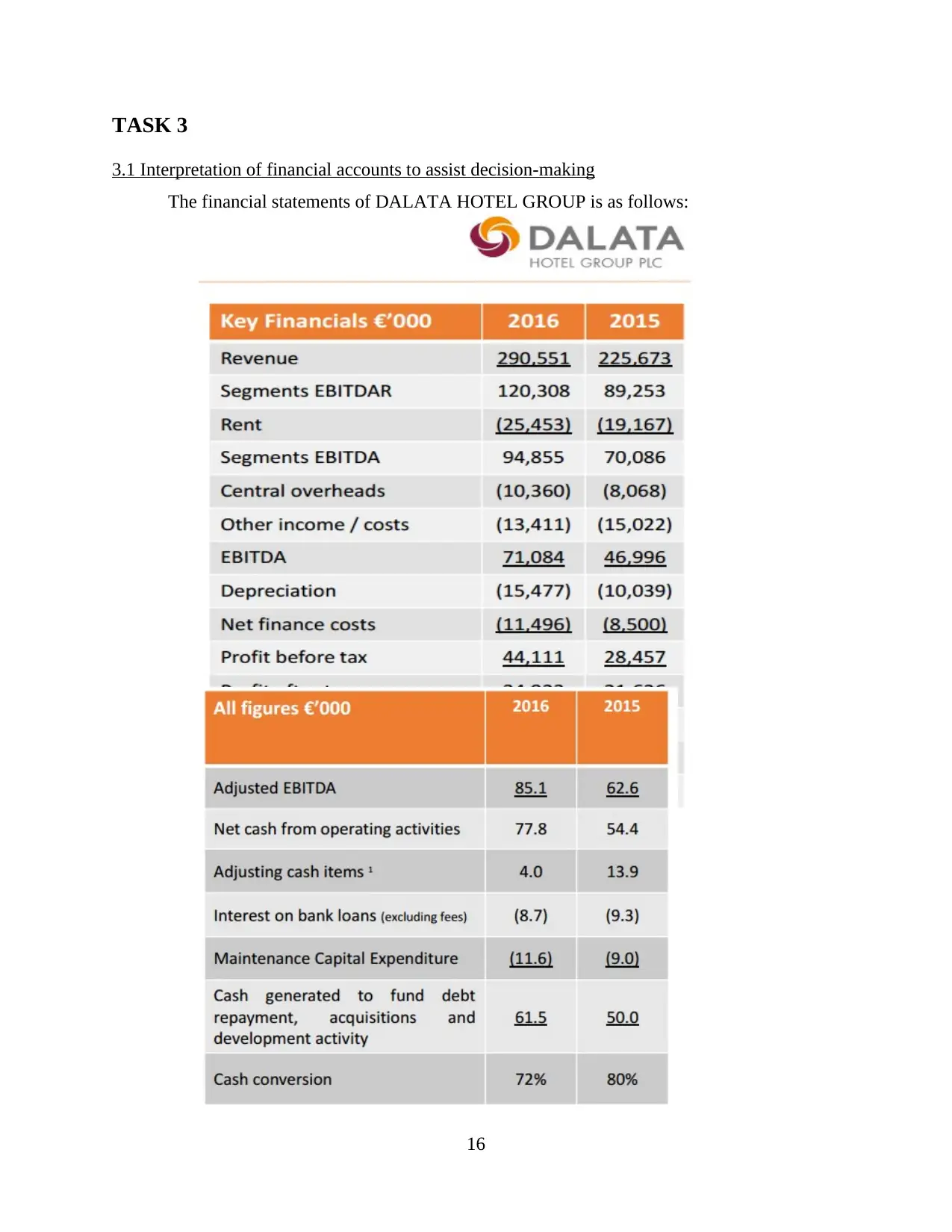
TASK 3
3.1 Interpretation of financial accounts to assist decision-making
The financial statements of DALATA HOTEL GROUP is as follows:
16
3.1 Interpretation of financial accounts to assist decision-making
The financial statements of DALATA HOTEL GROUP is as follows:
16
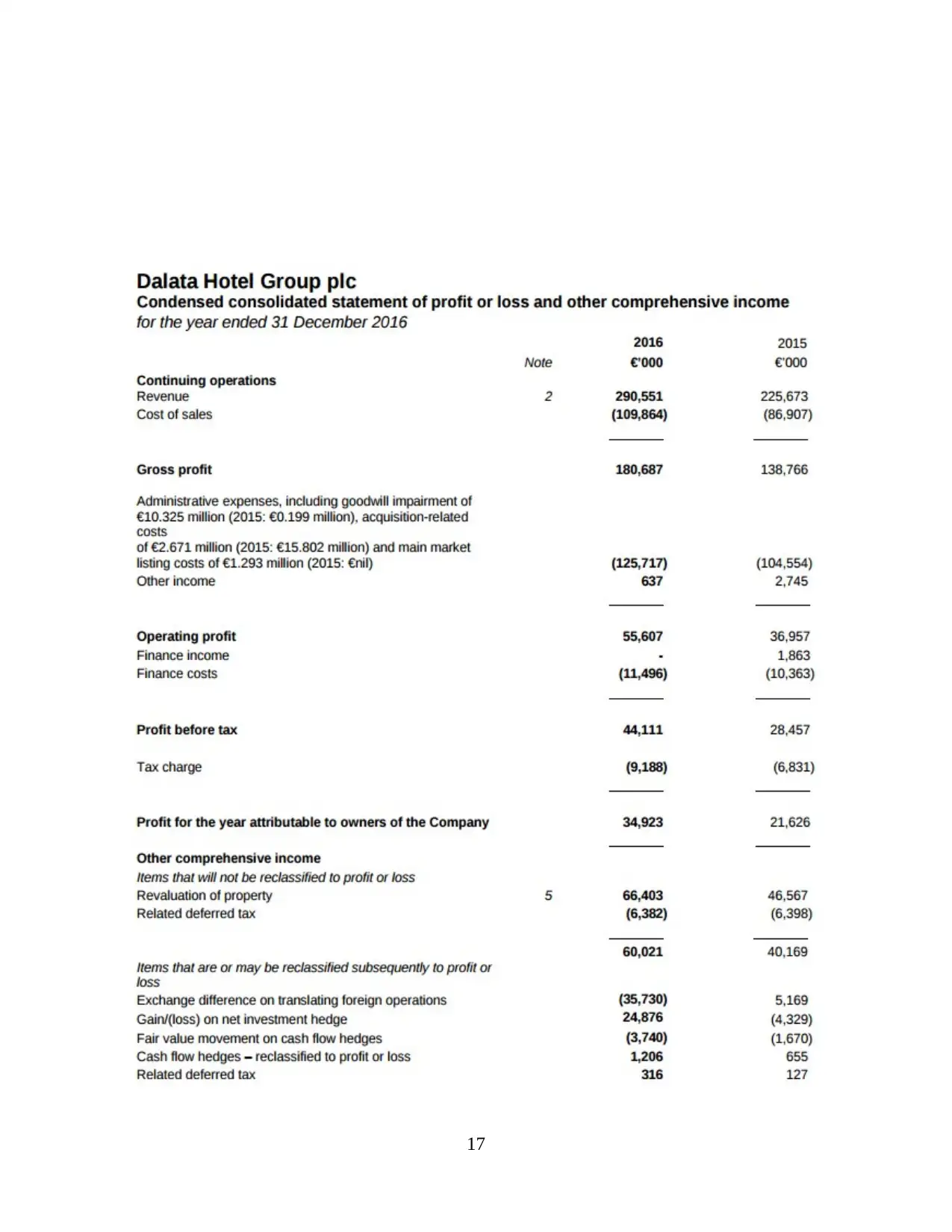
17
Paraphrase This Document
Need a fresh take? Get an instant paraphrase of this document with our AI Paraphraser
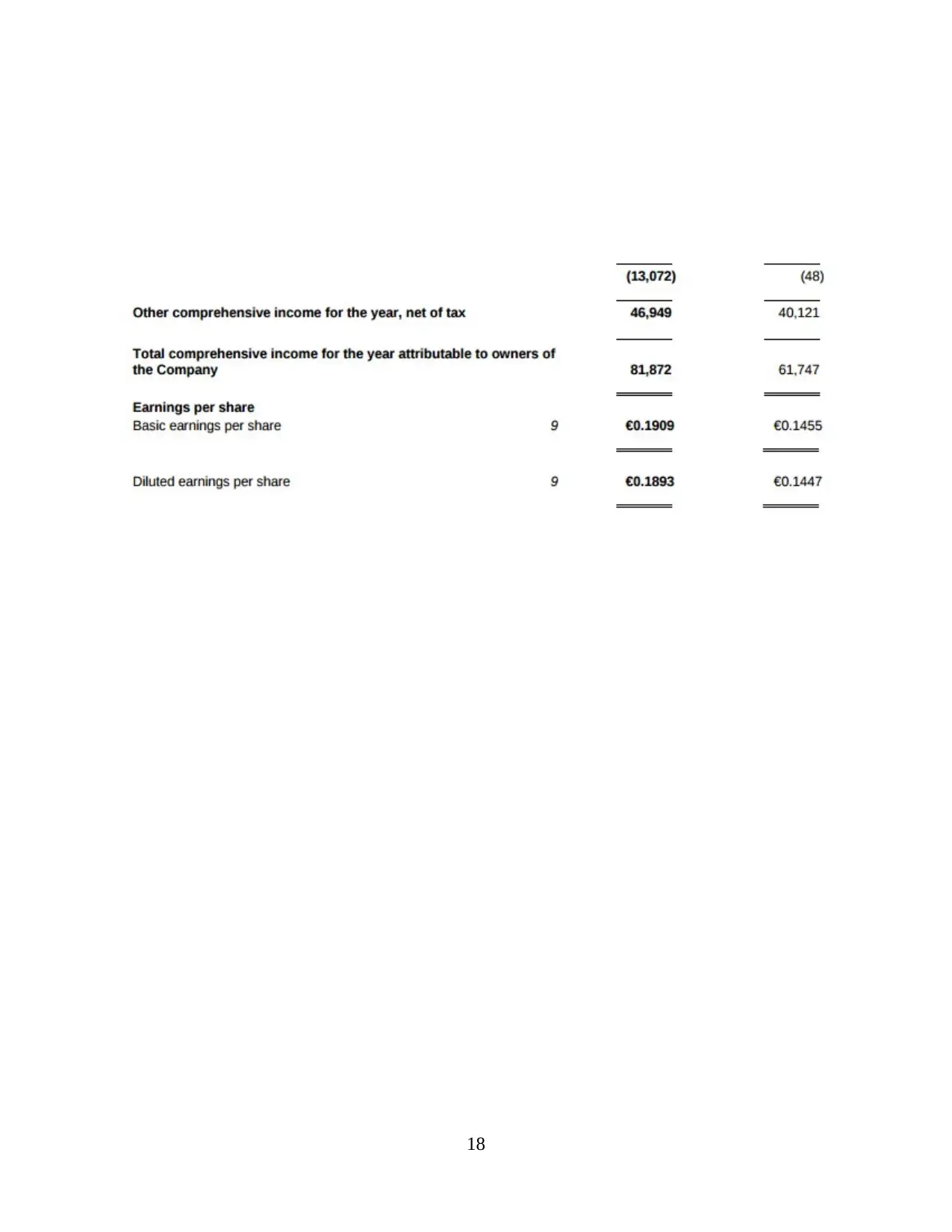
18
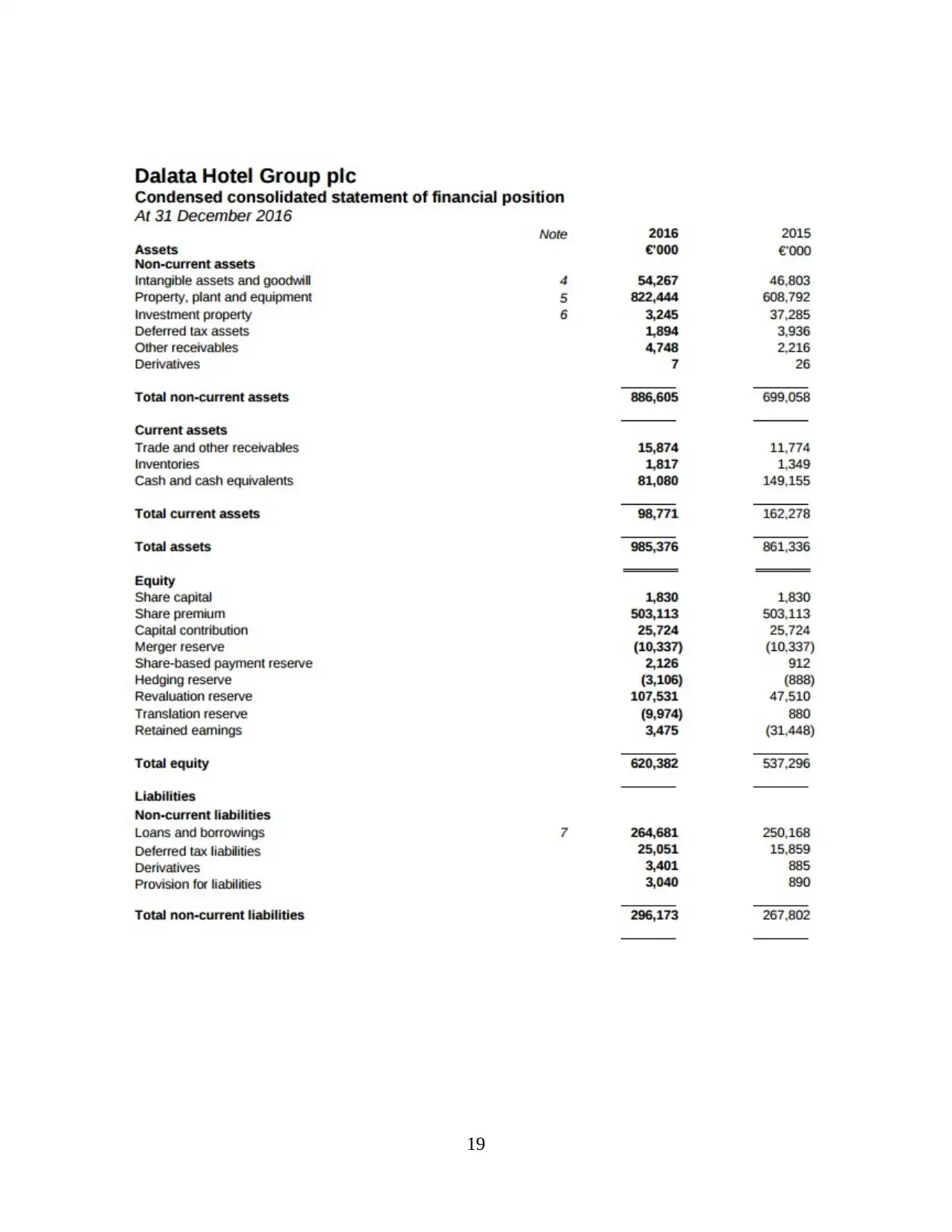
19
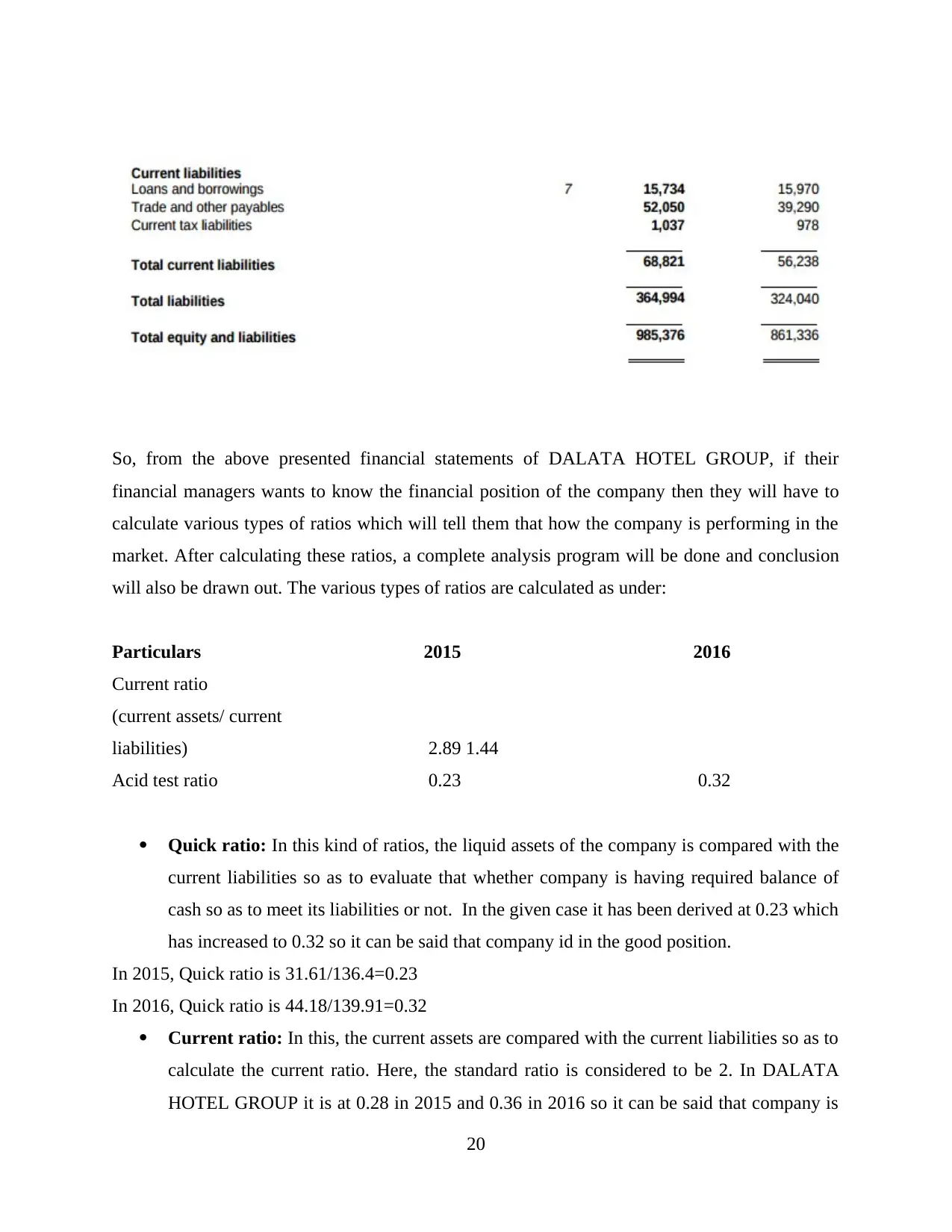
So, from the above presented financial statements of DALATA HOTEL GROUP, if their
financial managers wants to know the financial position of the company then they will have to
calculate various types of ratios which will tell them that how the company is performing in the
market. After calculating these ratios, a complete analysis program will be done and conclusion
will also be drawn out. The various types of ratios are calculated as under:
Particulars 2015 2016
Current ratio
(current assets/ current
liabilities) 2.89 1.44
Acid test ratio 0.23 0.32
Quick ratio: In this kind of ratios, the liquid assets of the company is compared with the
current liabilities so as to evaluate that whether company is having required balance of
cash so as to meet its liabilities or not. In the given case it has been derived at 0.23 which
has increased to 0.32 so it can be said that company id in the good position.
In 2015, Quick ratio is 31.61/136.4=0.23
In 2016, Quick ratio is 44.18/139.91=0.32
Current ratio: In this, the current assets are compared with the current liabilities so as to
calculate the current ratio. Here, the standard ratio is considered to be 2. In DALATA
HOTEL GROUP it is at 0.28 in 2015 and 0.36 in 2016 so it can be said that company is
20
financial managers wants to know the financial position of the company then they will have to
calculate various types of ratios which will tell them that how the company is performing in the
market. After calculating these ratios, a complete analysis program will be done and conclusion
will also be drawn out. The various types of ratios are calculated as under:
Particulars 2015 2016
Current ratio
(current assets/ current
liabilities) 2.89 1.44
Acid test ratio 0.23 0.32
Quick ratio: In this kind of ratios, the liquid assets of the company is compared with the
current liabilities so as to evaluate that whether company is having required balance of
cash so as to meet its liabilities or not. In the given case it has been derived at 0.23 which
has increased to 0.32 so it can be said that company id in the good position.
In 2015, Quick ratio is 31.61/136.4=0.23
In 2016, Quick ratio is 44.18/139.91=0.32
Current ratio: In this, the current assets are compared with the current liabilities so as to
calculate the current ratio. Here, the standard ratio is considered to be 2. In DALATA
HOTEL GROUP it is at 0.28 in 2015 and 0.36 in 2016 so it can be said that company is
20
Secure Best Marks with AI Grader
Need help grading? Try our AI Grader for instant feedback on your assignments.
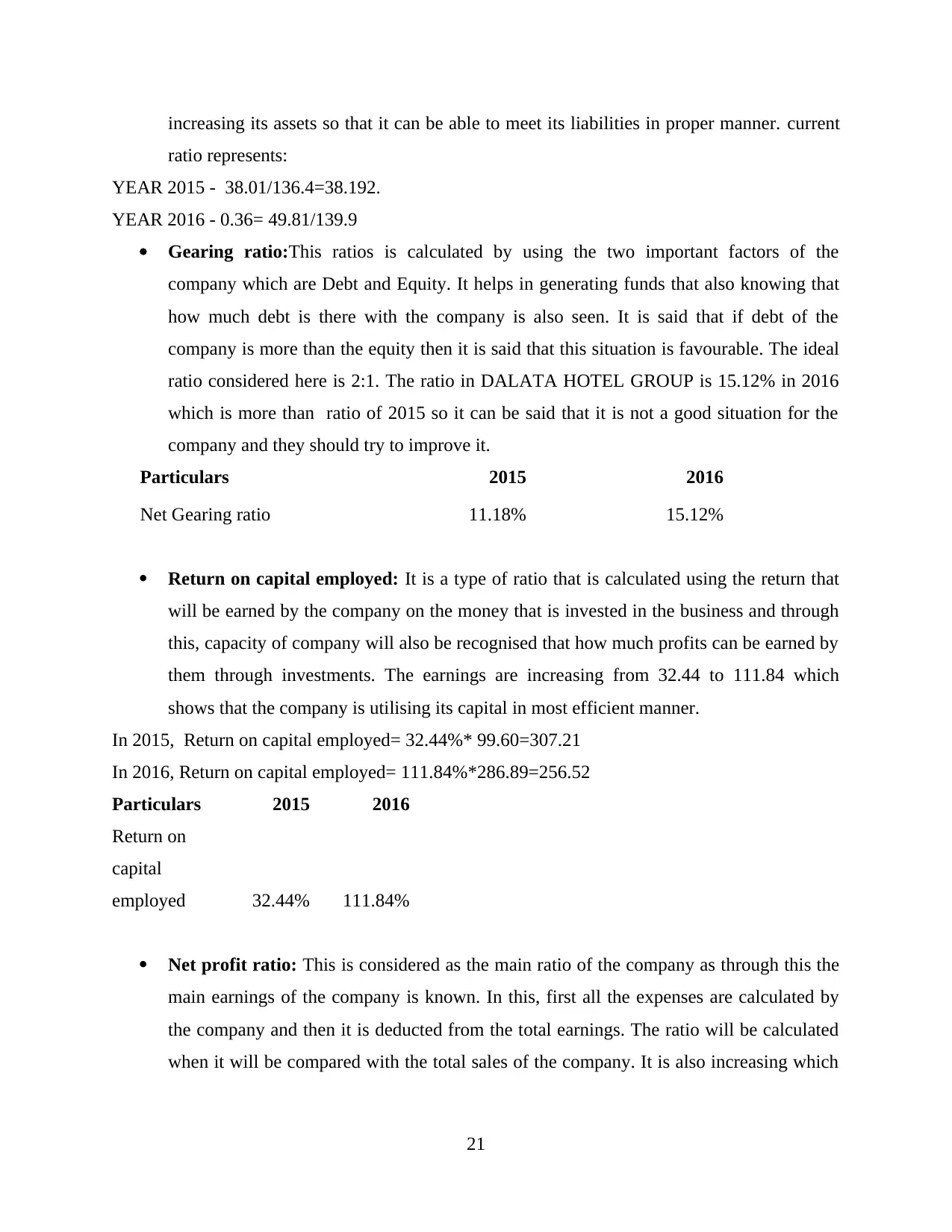
increasing its assets so that it can be able to meet its liabilities in proper manner. current
ratio represents:
YEAR 2015 - 38.01/136.4=38.192.
YEAR 2016 - 0.36= 49.81/139.9
Gearing ratio:This ratios is calculated by using the two important factors of the
company which are Debt and Equity. It helps in generating funds that also knowing that
how much debt is there with the company is also seen. It is said that if debt of the
company is more than the equity then it is said that this situation is favourable. The ideal
ratio considered here is 2:1. The ratio in DALATA HOTEL GROUP is 15.12% in 2016
which is more than ratio of 2015 so it can be said that it is not a good situation for the
company and they should try to improve it.
Particulars 2015 2016
Net Gearing ratio 11.18% 15.12%
Return on capital employed: It is a type of ratio that is calculated using the return that
will be earned by the company on the money that is invested in the business and through
this, capacity of company will also be recognised that how much profits can be earned by
them through investments. The earnings are increasing from 32.44 to 111.84 which
shows that the company is utilising its capital in most efficient manner.
In 2015, Return on capital employed= 32.44%* 99.60=307.21
In 2016, Return on capital employed= 111.84%*286.89=256.52
Particulars 2015 2016
Return on
capital
employed 32.44% 111.84%
Net profit ratio: This is considered as the main ratio of the company as through this the
main earnings of the company is known. In this, first all the expenses are calculated by
the company and then it is deducted from the total earnings. The ratio will be calculated
when it will be compared with the total sales of the company. It is also increasing which
21
ratio represents:
YEAR 2015 - 38.01/136.4=38.192.
YEAR 2016 - 0.36= 49.81/139.9
Gearing ratio:This ratios is calculated by using the two important factors of the
company which are Debt and Equity. It helps in generating funds that also knowing that
how much debt is there with the company is also seen. It is said that if debt of the
company is more than the equity then it is said that this situation is favourable. The ideal
ratio considered here is 2:1. The ratio in DALATA HOTEL GROUP is 15.12% in 2016
which is more than ratio of 2015 so it can be said that it is not a good situation for the
company and they should try to improve it.
Particulars 2015 2016
Net Gearing ratio 11.18% 15.12%
Return on capital employed: It is a type of ratio that is calculated using the return that
will be earned by the company on the money that is invested in the business and through
this, capacity of company will also be recognised that how much profits can be earned by
them through investments. The earnings are increasing from 32.44 to 111.84 which
shows that the company is utilising its capital in most efficient manner.
In 2015, Return on capital employed= 32.44%* 99.60=307.21
In 2016, Return on capital employed= 111.84%*286.89=256.52
Particulars 2015 2016
Return on
capital
employed 32.44% 111.84%
Net profit ratio: This is considered as the main ratio of the company as through this the
main earnings of the company is known. In this, first all the expenses are calculated by
the company and then it is deducted from the total earnings. The ratio will be calculated
when it will be compared with the total sales of the company. It is also increasing which
21
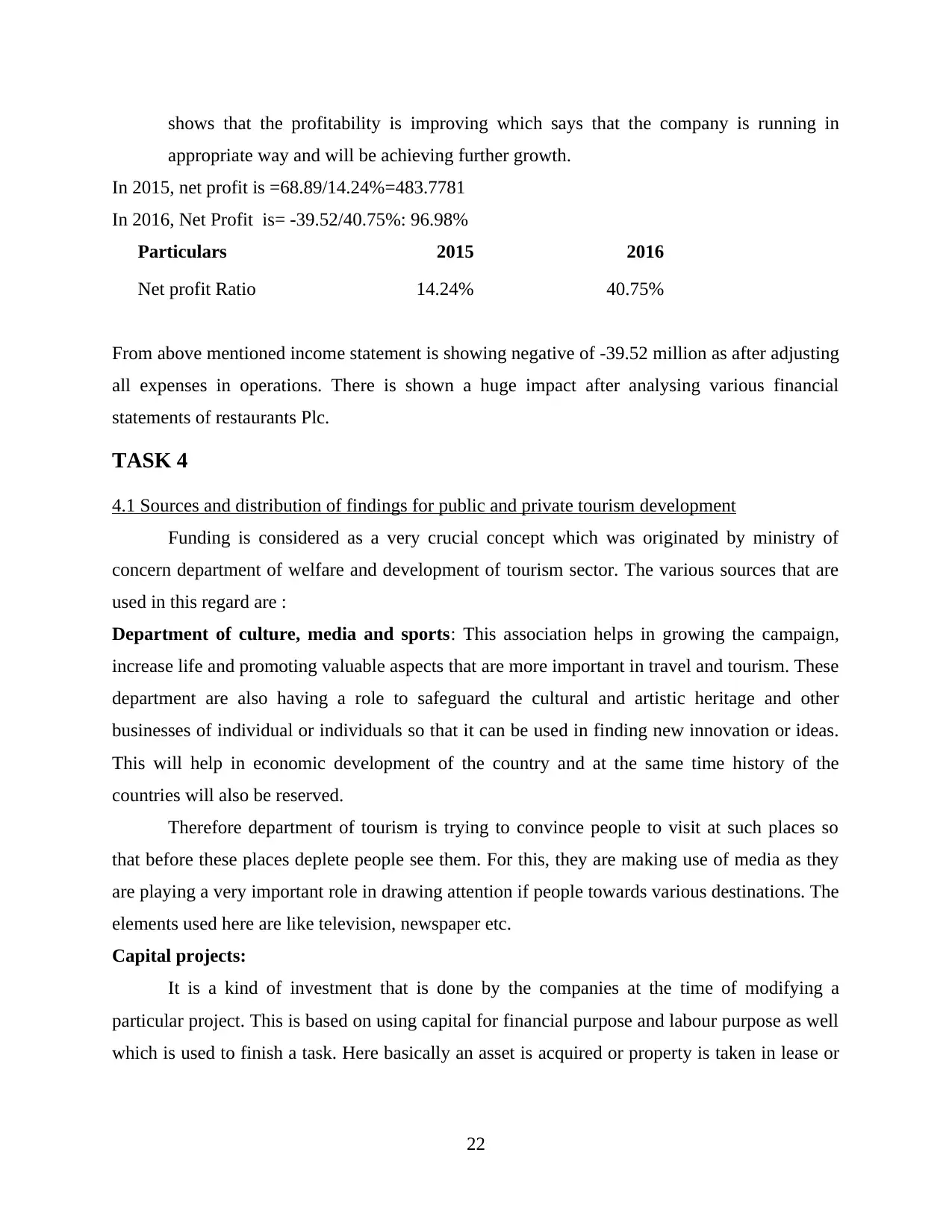
shows that the profitability is improving which says that the company is running in
appropriate way and will be achieving further growth.
In 2015, net profit is =68.89/14.24%=483.7781
In 2016, Net Profit is= -39.52/40.75%: 96.98%
Particulars 2015 2016
Net profit Ratio 14.24% 40.75%
From above mentioned income statement is showing negative of -39.52 million as after adjusting
all expenses in operations. There is shown a huge impact after analysing various financial
statements of restaurants Plc.
TASK 4
4.1 Sources and distribution of findings for public and private tourism development
Funding is considered as a very crucial concept which was originated by ministry of
concern department of welfare and development of tourism sector. The various sources that are
used in this regard are :
Department of culture, media and sports: This association helps in growing the campaign,
increase life and promoting valuable aspects that are more important in travel and tourism. These
department are also having a role to safeguard the cultural and artistic heritage and other
businesses of individual or individuals so that it can be used in finding new innovation or ideas.
This will help in economic development of the country and at the same time history of the
countries will also be reserved.
Therefore department of tourism is trying to convince people to visit at such places so
that before these places deplete people see them. For this, they are making use of media as they
are playing a very important role in drawing attention if people towards various destinations. The
elements used here are like television, newspaper etc.
Capital projects:
It is a kind of investment that is done by the companies at the time of modifying a
particular project. This is based on using capital for financial purpose and labour purpose as well
which is used to finish a task. Here basically an asset is acquired or property is taken in lease or
22
appropriate way and will be achieving further growth.
In 2015, net profit is =68.89/14.24%=483.7781
In 2016, Net Profit is= -39.52/40.75%: 96.98%
Particulars 2015 2016
Net profit Ratio 14.24% 40.75%
From above mentioned income statement is showing negative of -39.52 million as after adjusting
all expenses in operations. There is shown a huge impact after analysing various financial
statements of restaurants Plc.
TASK 4
4.1 Sources and distribution of findings for public and private tourism development
Funding is considered as a very crucial concept which was originated by ministry of
concern department of welfare and development of tourism sector. The various sources that are
used in this regard are :
Department of culture, media and sports: This association helps in growing the campaign,
increase life and promoting valuable aspects that are more important in travel and tourism. These
department are also having a role to safeguard the cultural and artistic heritage and other
businesses of individual or individuals so that it can be used in finding new innovation or ideas.
This will help in economic development of the country and at the same time history of the
countries will also be reserved.
Therefore department of tourism is trying to convince people to visit at such places so
that before these places deplete people see them. For this, they are making use of media as they
are playing a very important role in drawing attention if people towards various destinations. The
elements used here are like television, newspaper etc.
Capital projects:
It is a kind of investment that is done by the companies at the time of modifying a
particular project. This is based on using capital for financial purpose and labour purpose as well
which is used to finish a task. Here basically an asset is acquired or property is taken in lease or
22
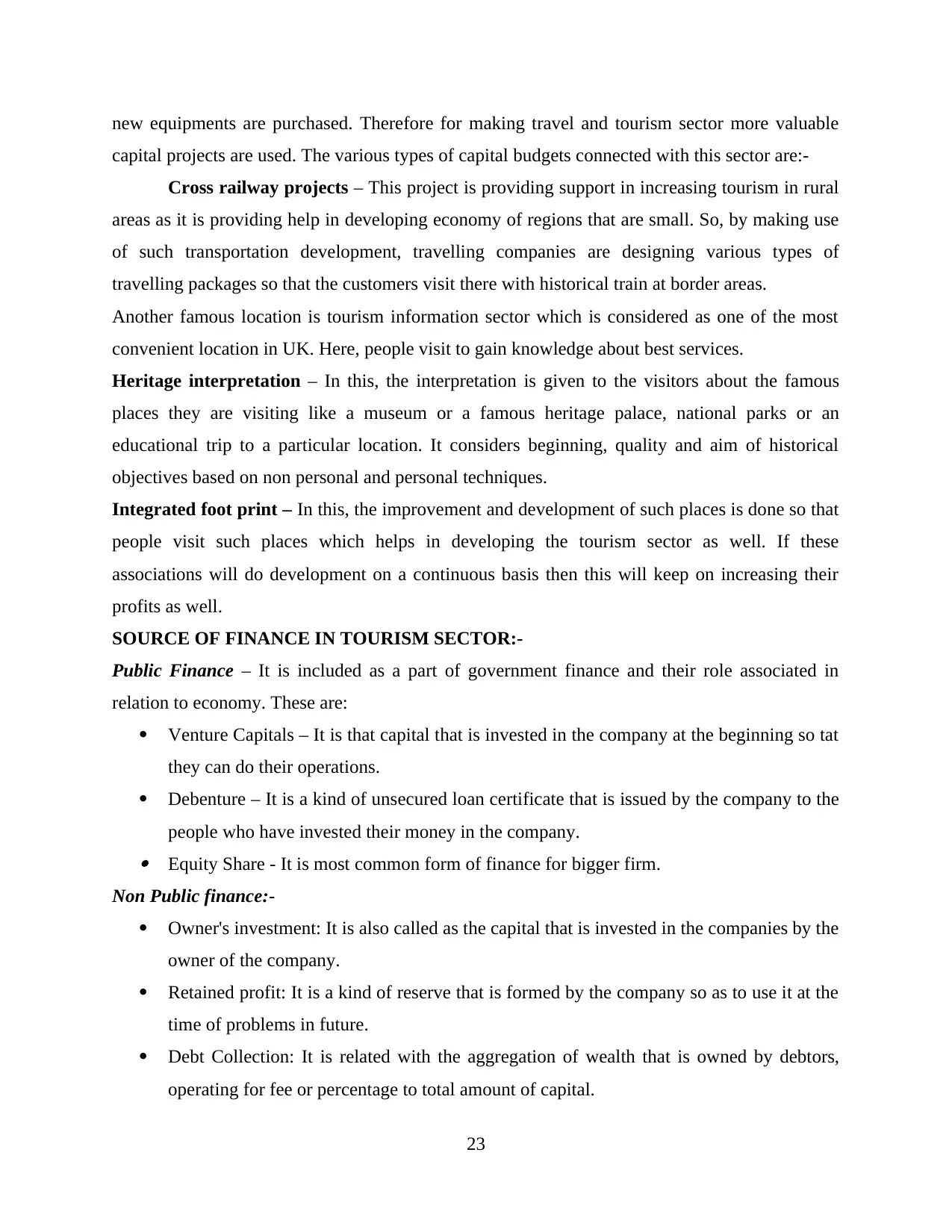
new equipments are purchased. Therefore for making travel and tourism sector more valuable
capital projects are used. The various types of capital budgets connected with this sector are:-
Cross railway projects – This project is providing support in increasing tourism in rural
areas as it is providing help in developing economy of regions that are small. So, by making use
of such transportation development, travelling companies are designing various types of
travelling packages so that the customers visit there with historical train at border areas.
Another famous location is tourism information sector which is considered as one of the most
convenient location in UK. Here, people visit to gain knowledge about best services.
Heritage interpretation – In this, the interpretation is given to the visitors about the famous
places they are visiting like a museum or a famous heritage palace, national parks or an
educational trip to a particular location. It considers beginning, quality and aim of historical
objectives based on non personal and personal techniques.
Integrated foot print – In this, the improvement and development of such places is done so that
people visit such places which helps in developing the tourism sector as well. If these
associations will do development on a continuous basis then this will keep on increasing their
profits as well.
SOURCE OF FINANCE IN TOURISM SECTOR:-
Public Finance – It is included as a part of government finance and their role associated in
relation to economy. These are:
Venture Capitals – It is that capital that is invested in the company at the beginning so tat
they can do their operations.
Debenture – It is a kind of unsecured loan certificate that is issued by the company to the
people who have invested their money in the company. Equity Share - It is most common form of finance for bigger firm.
Non Public finance:-
Owner's investment: It is also called as the capital that is invested in the companies by the
owner of the company.
Retained profit: It is a kind of reserve that is formed by the company so as to use it at the
time of problems in future.
Debt Collection: It is related with the aggregation of wealth that is owned by debtors,
operating for fee or percentage to total amount of capital.
23
capital projects are used. The various types of capital budgets connected with this sector are:-
Cross railway projects – This project is providing support in increasing tourism in rural
areas as it is providing help in developing economy of regions that are small. So, by making use
of such transportation development, travelling companies are designing various types of
travelling packages so that the customers visit there with historical train at border areas.
Another famous location is tourism information sector which is considered as one of the most
convenient location in UK. Here, people visit to gain knowledge about best services.
Heritage interpretation – In this, the interpretation is given to the visitors about the famous
places they are visiting like a museum or a famous heritage palace, national parks or an
educational trip to a particular location. It considers beginning, quality and aim of historical
objectives based on non personal and personal techniques.
Integrated foot print – In this, the improvement and development of such places is done so that
people visit such places which helps in developing the tourism sector as well. If these
associations will do development on a continuous basis then this will keep on increasing their
profits as well.
SOURCE OF FINANCE IN TOURISM SECTOR:-
Public Finance – It is included as a part of government finance and their role associated in
relation to economy. These are:
Venture Capitals – It is that capital that is invested in the company at the beginning so tat
they can do their operations.
Debenture – It is a kind of unsecured loan certificate that is issued by the company to the
people who have invested their money in the company. Equity Share - It is most common form of finance for bigger firm.
Non Public finance:-
Owner's investment: It is also called as the capital that is invested in the companies by the
owner of the company.
Retained profit: It is a kind of reserve that is formed by the company so as to use it at the
time of problems in future.
Debt Collection: It is related with the aggregation of wealth that is owned by debtors,
operating for fee or percentage to total amount of capital.
23
Paraphrase This Document
Need a fresh take? Get an instant paraphrase of this document with our AI Paraphraser
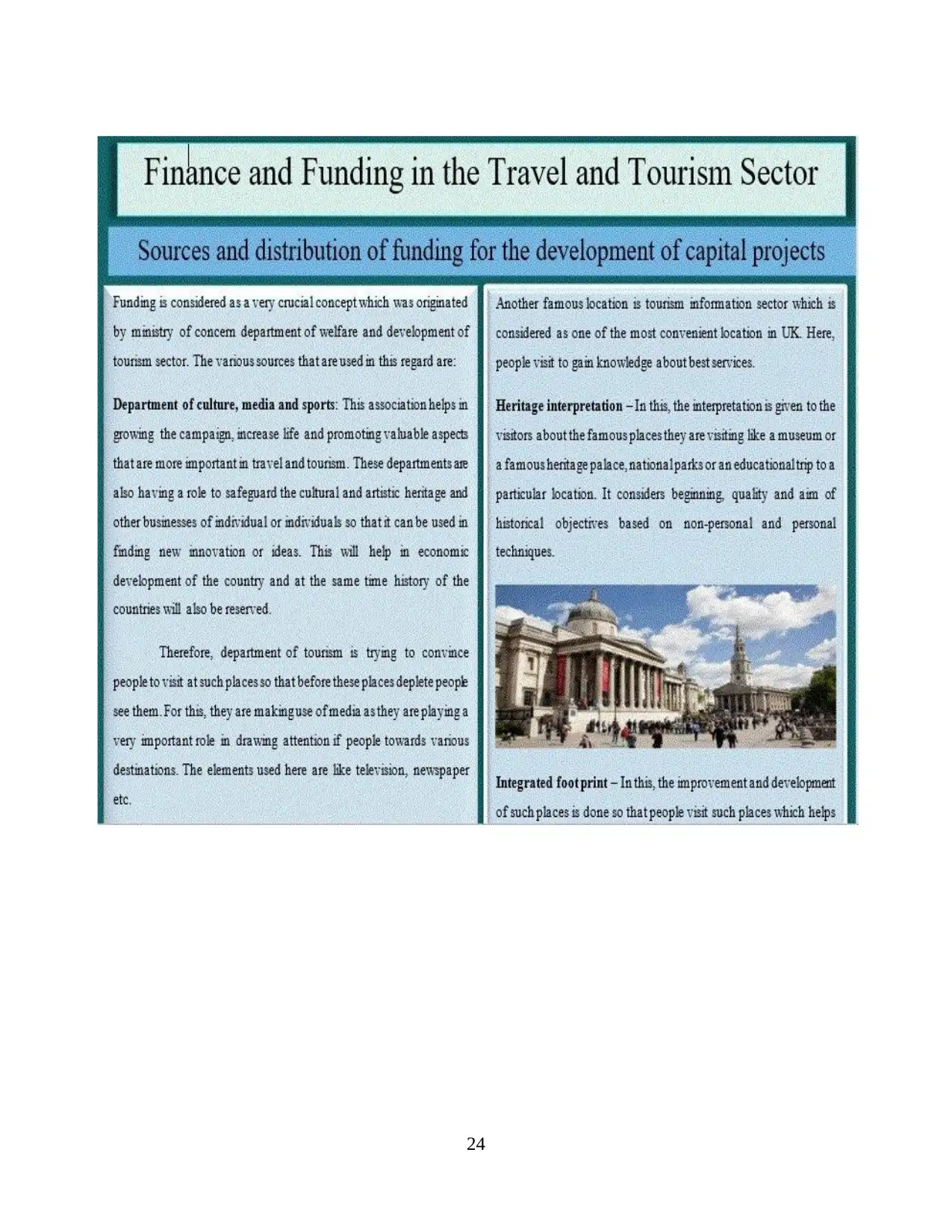
24
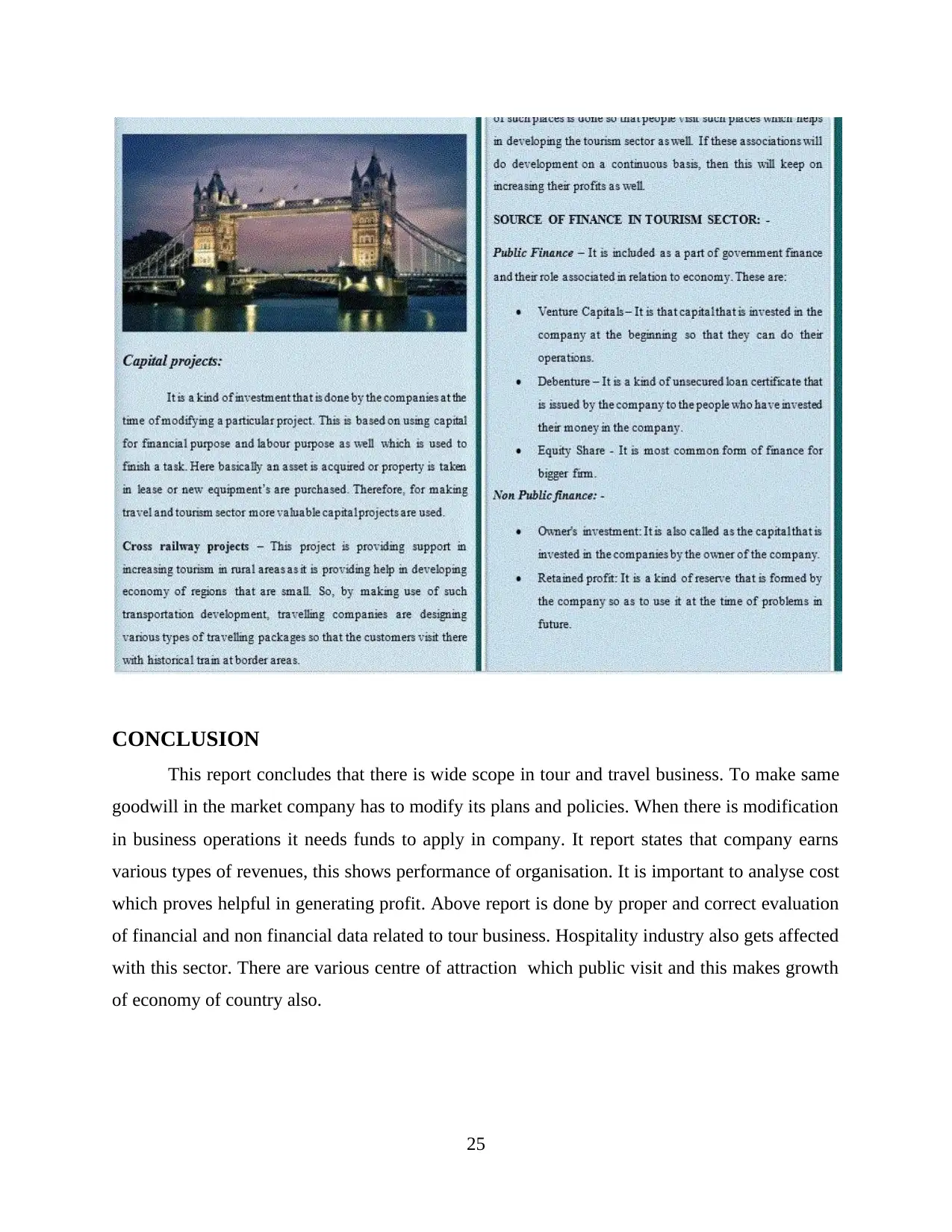
CONCLUSION
This report concludes that there is wide scope in tour and travel business. To make same
goodwill in the market company has to modify its plans and policies. When there is modification
in business operations it needs funds to apply in company. It report states that company earns
various types of revenues, this shows performance of organisation. It is important to analyse cost
which proves helpful in generating profit. Above report is done by proper and correct evaluation
of financial and non financial data related to tour business. Hospitality industry also gets affected
with this sector. There are various centre of attraction which public visit and this makes growth
of economy of country also.
25
This report concludes that there is wide scope in tour and travel business. To make same
goodwill in the market company has to modify its plans and policies. When there is modification
in business operations it needs funds to apply in company. It report states that company earns
various types of revenues, this shows performance of organisation. It is important to analyse cost
which proves helpful in generating profit. Above report is done by proper and correct evaluation
of financial and non financial data related to tour business. Hospitality industry also gets affected
with this sector. There are various centre of attraction which public visit and this makes growth
of economy of country also.
25
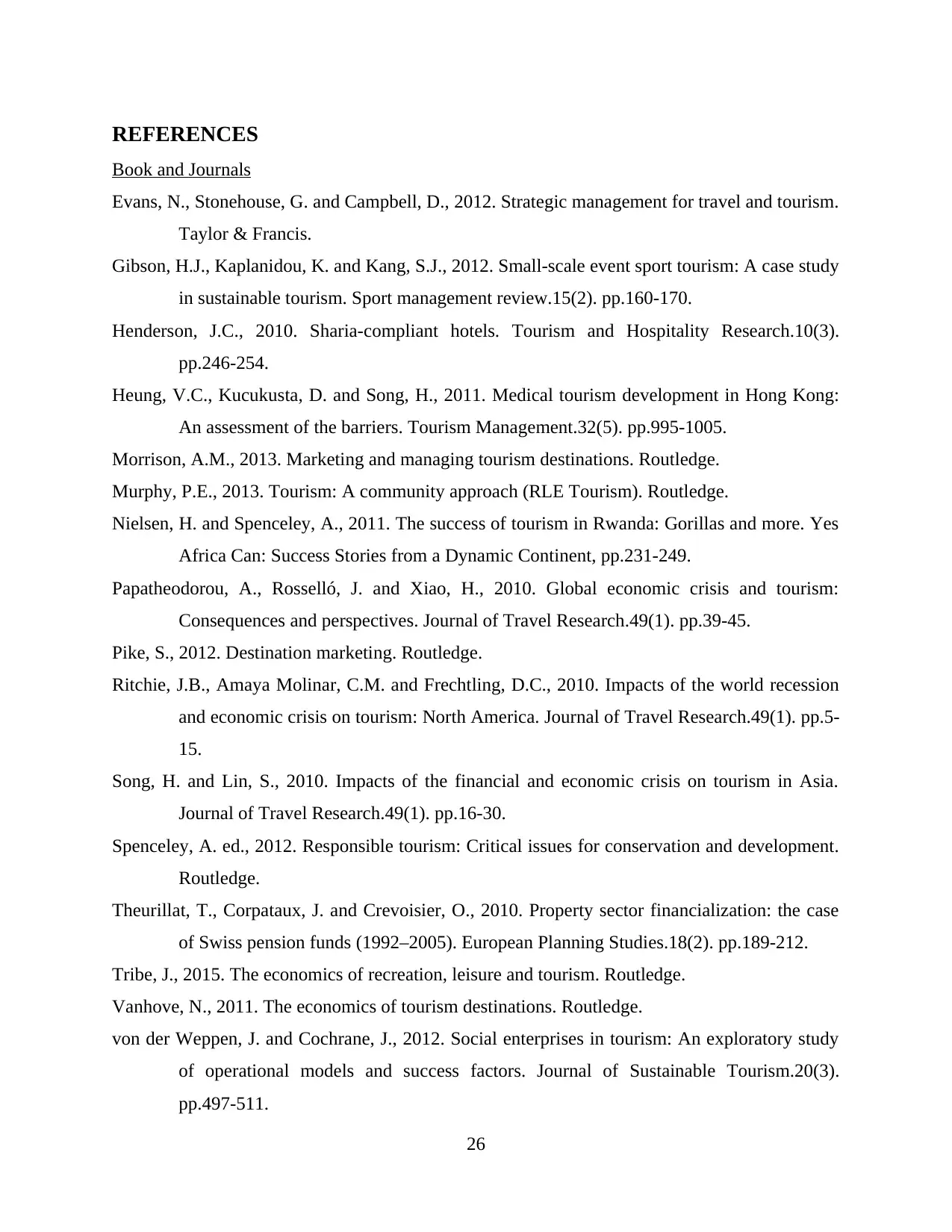
REFERENCES
Book and Journals
Evans, N., Stonehouse, G. and Campbell, D., 2012. Strategic management for travel and tourism.
Taylor & Francis.
Gibson, H.J., Kaplanidou, K. and Kang, S.J., 2012. Small-scale event sport tourism: A case study
in sustainable tourism. Sport management review.15(2). pp.160-170.
Henderson, J.C., 2010. Sharia-compliant hotels. Tourism and Hospitality Research.10(3).
pp.246-254.
Heung, V.C., Kucukusta, D. and Song, H., 2011. Medical tourism development in Hong Kong:
An assessment of the barriers. Tourism Management.32(5). pp.995-1005.
Morrison, A.M., 2013. Marketing and managing tourism destinations. Routledge.
Murphy, P.E., 2013. Tourism: A community approach (RLE Tourism). Routledge.
Nielsen, H. and Spenceley, A., 2011. The success of tourism in Rwanda: Gorillas and more. Yes
Africa Can: Success Stories from a Dynamic Continent, pp.231-249.
Papatheodorou, A., Rosselló, J. and Xiao, H., 2010. Global economic crisis and tourism:
Consequences and perspectives. Journal of Travel Research.49(1). pp.39-45.
Pike, S., 2012. Destination marketing. Routledge.
Ritchie, J.B., Amaya Molinar, C.M. and Frechtling, D.C., 2010. Impacts of the world recession
and economic crisis on tourism: North America. Journal of Travel Research.49(1). pp.5-
15.
Song, H. and Lin, S., 2010. Impacts of the financial and economic crisis on tourism in Asia.
Journal of Travel Research.49(1). pp.16-30.
Spenceley, A. ed., 2012. Responsible tourism: Critical issues for conservation and development.
Routledge.
Theurillat, T., Corpataux, J. and Crevoisier, O., 2010. Property sector financialization: the case
of Swiss pension funds (1992–2005). European Planning Studies.18(2). pp.189-212.
Tribe, J., 2015. The economics of recreation, leisure and tourism. Routledge.
Vanhove, N., 2011. The economics of tourism destinations. Routledge.
von der Weppen, J. and Cochrane, J., 2012. Social enterprises in tourism: An exploratory study
of operational models and success factors. Journal of Sustainable Tourism.20(3).
pp.497-511.
26
Book and Journals
Evans, N., Stonehouse, G. and Campbell, D., 2012. Strategic management for travel and tourism.
Taylor & Francis.
Gibson, H.J., Kaplanidou, K. and Kang, S.J., 2012. Small-scale event sport tourism: A case study
in sustainable tourism. Sport management review.15(2). pp.160-170.
Henderson, J.C., 2010. Sharia-compliant hotels. Tourism and Hospitality Research.10(3).
pp.246-254.
Heung, V.C., Kucukusta, D. and Song, H., 2011. Medical tourism development in Hong Kong:
An assessment of the barriers. Tourism Management.32(5). pp.995-1005.
Morrison, A.M., 2013. Marketing and managing tourism destinations. Routledge.
Murphy, P.E., 2013. Tourism: A community approach (RLE Tourism). Routledge.
Nielsen, H. and Spenceley, A., 2011. The success of tourism in Rwanda: Gorillas and more. Yes
Africa Can: Success Stories from a Dynamic Continent, pp.231-249.
Papatheodorou, A., Rosselló, J. and Xiao, H., 2010. Global economic crisis and tourism:
Consequences and perspectives. Journal of Travel Research.49(1). pp.39-45.
Pike, S., 2012. Destination marketing. Routledge.
Ritchie, J.B., Amaya Molinar, C.M. and Frechtling, D.C., 2010. Impacts of the world recession
and economic crisis on tourism: North America. Journal of Travel Research.49(1). pp.5-
15.
Song, H. and Lin, S., 2010. Impacts of the financial and economic crisis on tourism in Asia.
Journal of Travel Research.49(1). pp.16-30.
Spenceley, A. ed., 2012. Responsible tourism: Critical issues for conservation and development.
Routledge.
Theurillat, T., Corpataux, J. and Crevoisier, O., 2010. Property sector financialization: the case
of Swiss pension funds (1992–2005). European Planning Studies.18(2). pp.189-212.
Tribe, J., 2015. The economics of recreation, leisure and tourism. Routledge.
Vanhove, N., 2011. The economics of tourism destinations. Routledge.
von der Weppen, J. and Cochrane, J., 2012. Social enterprises in tourism: An exploratory study
of operational models and success factors. Journal of Sustainable Tourism.20(3).
pp.497-511.
26
Secure Best Marks with AI Grader
Need help grading? Try our AI Grader for instant feedback on your assignments.
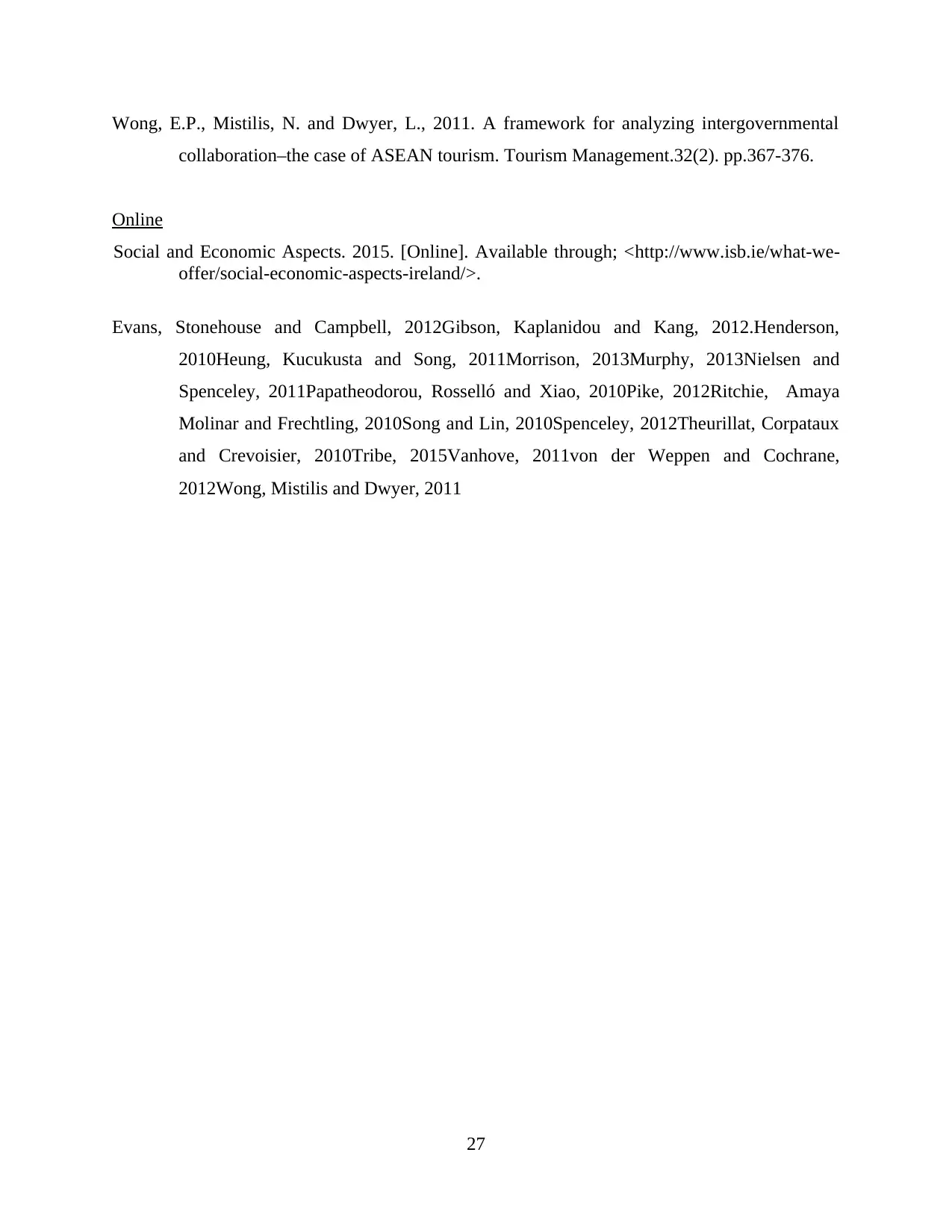
Wong, E.P., Mistilis, N. and Dwyer, L., 2011. A framework for analyzing intergovernmental
collaboration–the case of ASEAN tourism. Tourism Management.32(2). pp.367-376.
Online
Social and Economic Aspects. 2015. [Online]. Available through; <http://www.isb.ie/what-we-
offer/social-economic-aspects-ireland/>.
Evans, Stonehouse and Campbell, 2012Gibson, Kaplanidou and Kang, 2012.Henderson,
2010Heung, Kucukusta and Song, 2011Morrison, 2013Murphy, 2013Nielsen and
Spenceley, 2011Papatheodorou, Rosselló and Xiao, 2010Pike, 2012Ritchie, Amaya
Molinar and Frechtling, 2010Song and Lin, 2010Spenceley, 2012Theurillat, Corpataux
and Crevoisier, 2010Tribe, 2015Vanhove, 2011von der Weppen and Cochrane,
2012Wong, Mistilis and Dwyer, 2011
27
collaboration–the case of ASEAN tourism. Tourism Management.32(2). pp.367-376.
Online
Social and Economic Aspects. 2015. [Online]. Available through; <http://www.isb.ie/what-we-
offer/social-economic-aspects-ireland/>.
Evans, Stonehouse and Campbell, 2012Gibson, Kaplanidou and Kang, 2012.Henderson,
2010Heung, Kucukusta and Song, 2011Morrison, 2013Murphy, 2013Nielsen and
Spenceley, 2011Papatheodorou, Rosselló and Xiao, 2010Pike, 2012Ritchie, Amaya
Molinar and Frechtling, 2010Song and Lin, 2010Spenceley, 2012Theurillat, Corpataux
and Crevoisier, 2010Tribe, 2015Vanhove, 2011von der Weppen and Cochrane,
2012Wong, Mistilis and Dwyer, 2011
27
1 out of 29
Related Documents
Your All-in-One AI-Powered Toolkit for Academic Success.
+13062052269
info@desklib.com
Available 24*7 on WhatsApp / Email
![[object Object]](/_next/static/media/star-bottom.7253800d.svg)
Unlock your academic potential
© 2024 | Zucol Services PVT LTD | All rights reserved.





